ecom instruments 300011GR02 Ci70 User Manual
ecom instruments GmbH Ci70
Contents
user manual
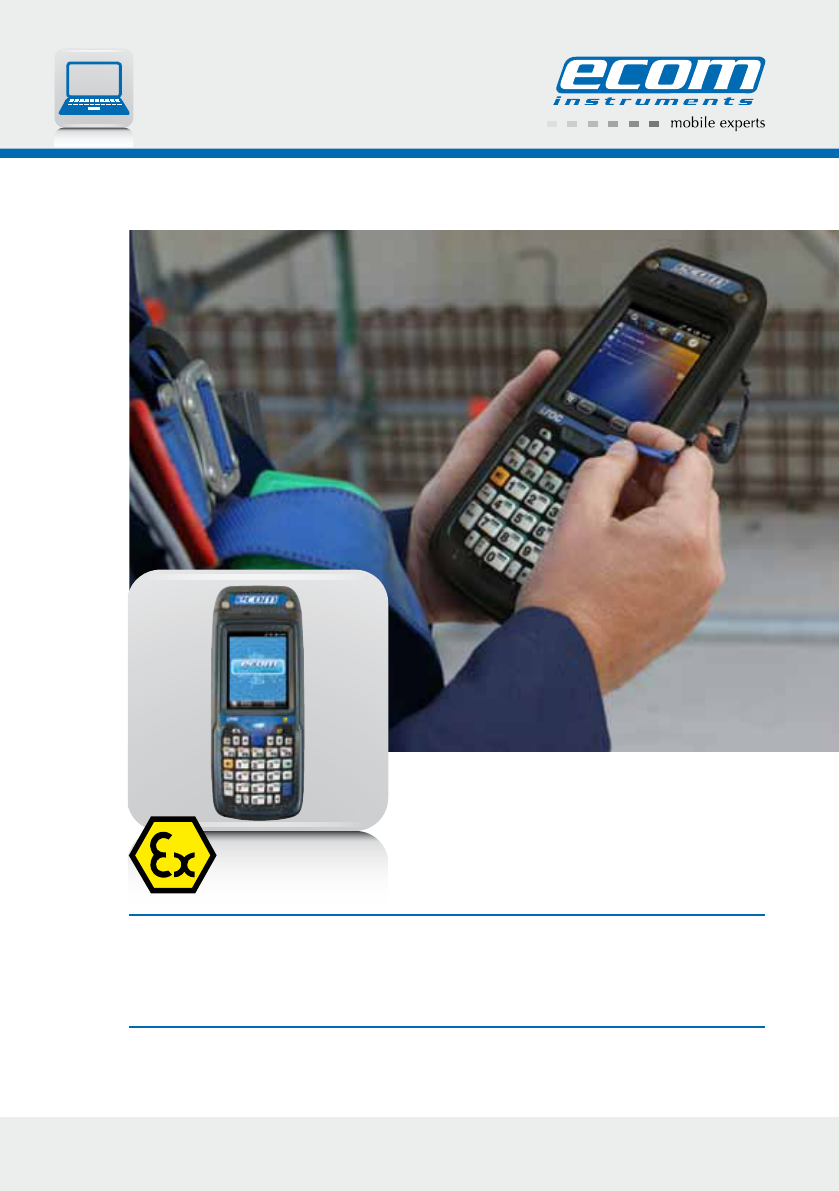
1
i.roc® Ci70 -Ex
Manual
Mobile Computing
2 3
Content
Before You Begin ������������������������������������������������������������������������������������������������������������������������������������������������������������������������� 5
Global Services and Support �������������������������������������������������������������������������������������������������������������������������������������������������� 5
Who Should Read This Manual ����������������������������������������������������������������������������������������������������������������������������������������������� 5
1 About the Computer Features ��������������������������������������������������������������������������������������������������������������������������6
About the i�roc® Ci70 -Ex Mobile Computers �������������������������������������������������������������������������������������������������������������������� 7
Overview of i�roc® Ci70 -Ex Features ����������������������������������������������������������������������������������������������������������������������������������� 7
About the Status LEDs ��������������������������������������������������������������������������������������������������������������������������������������������������������������� 8
About Language Provisioning �������������������������������������������������������������������������������������������������������������������������������������������������� 9
About the Battery L ��������������������������������������������������������������������������������������������������������������������������������������������������������������������� 9
Charge the Battery ���������������������������������������������������������������������������������������������������������������������������������������������������������������������� 9
Change the Battery ��������������������������������������������������������������������������������������������������������������������������������������������������������������������� 9
About Battery Status �����������������������������������������������������������������������������������������������������������������������������������������������������������������10
About Battery Life and Conservation �����������������������������������������������������������������������������������������������������������������������������������11
About the Keypad ����������������������������������������������������������������������������������������������������������������������������������������������������������������������12
Enter Characters on the QWERTY Keypad �����������������������������������������������������������������������������������������������������������������������12
Enter Characters on the Numeric Keypad �������������������������������������������������������������������������������������������������������������������������13
About the Power Button �����������������������������������������������������������������������������������������������������������������������������������������������������������13
About the Intermec Dashboard Button �������������������������������������������������������������������������������������������������������������������������������14
Configure the Screen Backlight ��������������������������������������������������������������������������������������������������������������������������������������������14
Adjust the Volume ���������������������������������������������������������������������������������������������������������������������������������������������������������������������� 15
Insert a microSD Card �������������������������������������������������������������������������������������������������������������������������������������������������������������15
Install a microSD card in a i�roc® Ci70 -Ex ���������������������������������������������������������������������������������������������������������������������15
Transfer Files To and From Your PC ������������������������������������������������������������������������������������������������������������������������������������16
Use Microsoft ActiveSync to Transfer Files �����������������������������������������������������������������������������������������������������������������������17
Use the Computer as a Mass Storage Device ������������������������������������������������������������������������������������������������������������������17
2 About the User Interface and ��������������������������������������������������������������������������������������������������������������������������18
Intermec Applications ���������������������������������������������������������������������������������������������������������������������������������������������������������������18
About the User Interface����������������������������������������������������������������������������������������������������������������������������������������������������������19
About the Home Screen ����������������������������������������������������������������������������������������������������������������������������������������������������������19
Interact With the Screen ����������������������������������������������������������������������������������������������������������������������������������������������������������20
Title Bar Status Icons ���������������������������������������������������������������������������������������������������������������������������������������������������������������21
Align the Screen ������������������������������������������������������������������������������������������������������������������������������������������������������������������������24
About ecom instruments Applications ��������������������������������������������������������������������������������������������������������������������������������24
Applications Available on the Mobile Computer ��������������������������������������������������������������������������������������������������������������24
3 Use the WWAN Module �������������������������������������������������������������������������������������������������������������������������������������26
About the WWAN Module �������������������������������������������������������������������������������������������������������������������������������������������������������� 27
Activate the UMTS Module �����������������������������������������������������������������������������������������������������������������������������������������������������27
Activate the CDMA Phone �������������������������������������������������������������������������������������������������������������������������������������������������������28
Turn the WWAN Module On and Off ������������������������������������������������������������������������������������������������������������������������������������28
About Switching Network Carriers ���������������������������������������������������������������������������������������������������������������������������������������29
About the Network Connection ���������������������������������������������������������������������������������������������������������������������������������������������29
Switch Network Carriers����������������������������������������������������������������������������������������������������������������������������������������������������������29
4 Use GPS �����������������������������������������������������������������������������������������������������������������������������������������������������������������30
About the Integrated GPS on Your Computer�������������������������������������������������������������������������������������������������������������������31
Use the GPSID Installed on the Computer �������������������������������������������������������������������������������������������������������������������������31
Improve GPS Performance on the Computer �������������������������������������������������������������������������������������������������������������������32
5 Configure the computer �����������������������������������������������������������������������������������������������������������������������������������34
How to Configure the Computer �������������������������������������������������������������������������������������������������������������������������������������������35
Use Intermec Settings on the Computer ����������������������������������������������������������������������������������������������������������������������������35
Start Intermec Settings ������������������������������������������������������������������������������������������������������������������������������������������������������������35
About the Structure of Intermec Settings ���������������������������������������������������������������������������������������������������������������������������35
Navigate in Intermec Settings ������������������������������������������������������������������������������������������������������������������������������������������������39
Configure Profile Settings With Intermec Settings ����������������������������������������������������������������������������������������������������������39
Restore Default Settings ����������������������������������������������������������������������������������������������������������������������������������������������������������39
Hide Menu Items in Intermec Settings ��������������������������������������������������������������������������������������������������������������������������������39
Use Intermec Settings Remotely With ���������������������������������������������������������������������������������������������������������������������������������40
SmartSystems Foundation �����������������������������������������������������������������������������������������������������������������������������������������������������40
About Network Communications ������������������������������������������������������������������������������������������������������������������������������������������40
Configure 802�11a/b/g/n (Wi-Fi) Radio Communications �������������������������������������������������������������������������������������������40
Configure Bluetooth Communications ��������������������������������������������������������������������������������������������������������������������������������41
Connect to a Bluetooth Scanner ������������������������������������������������������������������������������������������������������������������������������������������41
Connect to a Bluetooth Printer ����������������������������������������������������������������������������������������������������������������������������������������������42
Connect to a Bluetooth Audio Device ���������������������������������������������������������������������������������������������������������������������������������42
Create an ISP Connection ������������������������������������������������������������������������������������������������������������������������������������������������������43
Create a VPN Server Connection �����������������������������������������������������������������������������������������������������������������������������������������44
About Wireless Security ����������������������������������������������������������������������������������������������������������������������������������������������������������44
Choose Between Microsoft and Funk Security ����������������������������������������������������������������������������������������������������������������45
Select a Funk Security Profile �����������������������������������������������������������������������������������������������������������������������������������������������45
Load a Certificate ����������������������������������������������������������������������������������������������������������������������������������������������������������������������50
6 Manage the computer ���������������������������������������������������������������������������������������������������������������������������������������52
Manage the Computer in Your Network �����������������������������������������������������������������������������������������������������������������������������53
Manage the Computer Using SmartSystems Foundation �������������������������������������������������������������������������������������������53
Manage the Computer Using Third-Party Software ��������������������������������������������������������������������������������������������������������54
Develop and Install Applications �������������������������������������������������������������������������������������������������������������������������������������������54
Package Your Application �������������������������������������������������������������������������������������������������������������������������������������������������������54
Choose a Target Location �������������������������������������������������������������������������������������������������������������������������������������������������������54
Install Applications Using SmartSystems Foundation Console ����������������������������������������������������������������������������������54
Install Applications Using Microsoft ActiveSync �������������������������������������������������������������������������������������������������������������55
4 5
Before You Begin
This section provides you with safety information, technical support
information, and sources for additional product information.
Safety Information L
Your safety is extremely important. Read and follow cautions in this document before handling
and operating ecom instruments equipment. You can be seriously injured, and equipment and
data can be damaged if you do not follow the safety cautions. This section explains how to
identify and understand cautions and notes that are in this document.
L
A caution alerts you to an operating procedure, practice, condition, or statement that must be
strictly observed to prevent equipment damage or destruction, or corruption or loss of data�
Note: Notes either provide extra information about a topic or contain special instructions
for handling a particular condition or set of circumstances�
Global Services and Support
Warranty Information
To understand the warranty for your ecom instruments product, visit the ecom instruments website
at www.ecom-ex.com and click Service.
Disclaimer of warranties: The sample code included in this document is presented for reference
only. The code does not necessarily represent complete, tested programs. The code is provided
“as is with all faults.” All warranties are expressly disclaimed, including the implied warranties of
merchantability and tness for a particular purpose.
Web Support
Visit the ecom instruments website at www.ecom-ex.com to download our current manuals (in PDF
format).
Telephone Support
For any questions contact your local ecom instruments representative. To search for your local
representative visit the ecom instruments website and click Contact > Locations.
Who Should Read This Manual
This manual is written for the person who is responsible for installing, conguring, and maintaining
the i.roc® Ci70 -Ex Mobile Computer. This manual provides you with information about the features
of the i.roc® Ci70 -Ex mobile computer, and how to install, congure, operate, maintain, and
troubleshoot it. Before you work with the i.roc® Ci70 -Ex mobile computer, you should be familiar
with your network and general networking terms, such as IP address.
Install Applications Using a Storage Card ������������������������������������������������������������������������������������������������������������������������ 55
Launch Applications Automatically ������������������������������������������������������������������������������������������������������������������������������������� 55
Update the System Software ������������������������������������������������������������������������������������������������������������������������������������������������ 55
Update Individual or Multiple Computers Using the SmartSystems Console �������������������������������������������������������� 55
Update Individual Mobile Computers Using a microSD Card ������������������������������������������������������������������������������������� 56
7 Troubleshoot and Maintain the computer ������������������������������������������������������������������������������������������������� 58
About the Intermec Dashboard �������������������������������������������������������������������������������������������������������������������������������������������� 59
Troubleshoot Your Mobile Computer ���������������������������������������������������������������������������������������������������������������������������������� 59
Troubleshoot the Wi-Fi Connection������������������������������������������������������������������������������������������������������������������������������������� 59
Troubleshoot 802�1x Security ����������������������������������������������������������������������������������������������������������������������������������������������� 60
Check 802�11 Network Status ���������������������������������������������������������������������������������������������������������������������������������������������� 61
Troubleshoot Reading Bar Codes ��������������������������������������������������������������������������������������������������������������������������������������� 61
Use ScanDiagnostic to Troubleshoot the Scanner �������������������������������������������������������������������������������������������������������� 63
Troubleshoot Operating the Computer ������������������������������������������������������������������������������������������������������������������������������ 63
Find Your Configuration Number ����������������������������������������������������������������������������������������������������������������������������������������� 64
Reset the Computer ����������������������������������������������������������������������������������������������������������������������������������������������������������������� 64
Reboot the Computer �������������������������������������������������������������������������������������������������������������������������������������������������������������� 64
Cold Boot the Computer ��������������������������������������������������������������������������������������������������������������������������������������������������������� 64
Clean Boot the Computer������������������������������������������������������������������������������������������������������������������������������������������������������� 65
Clean the Computer ����������������������������������������������������������������������������������������������������������������������������������������������������������������� 65
A Specifications and Default Settings ������������������������������������������������������������������������������������������������������������ 66
Physical and Environmental Specifications ��������������������������������������������������������������������������������������������������������������������� 67
i�roc® Ci70 -Ex Physical Dimensions ��������������������������������������������������������������������������������������������������������������������������������� 67
Environmental Specifications ����������������������������������������������������������������������������������������������������������������������������������������������� 67
Power and Electrical Specifications ����������������������������������������������������������������������������������������������������������������������������������� 67
Operating System ��������������������������������������������������������������������������������������������������������������������������������������������������������������������� 67
Hardware ������������������������������������������������������������������������������������������������������������������������������������������������������������������������������������� 67
Touch Screen Specifications ������������������������������������������������������������������������������������������������������������������������������������������������ 68
Standard Communications ���������������������������������������������������������������������������������������������������������������������������������������������������� 68
Optional Communications������������������������������������������������������������������������������������������������������������������������������������������������������ 68
Wireless LAN ������������������������������������������������������������������������������������������������������������������������������������������������������������������������������ 68
Regulatory Approvals �������������������������������������������������������������������������������������������������������������������������������������������������������������� 68
Communications ����������������������������������������������������������������������������������������������������������������������������������������������������������������������� 68
Device Settings�������������������������������������������������������������������������������������������������������������������������������������������������������������������������� 69
Core Messaging Service Settings ��������������������������������������������������������������������������������������������������������������������������������������� 71
Device Monitor Settings ���������������������������������������������������������������������������������������������������������������������������������������������������������� 71
Head Modules Settings ���������������������������������������������������������������������������������������������������������������������������������������������������������� 72
Virtual Wedge Settings ������������������������������������������������������������������������������������������������������������������������������������������������������������ 72
B Keypads and Keystrokes �������������������������������������������������������������������������������������������������������������������������������� 74
Standard Characters ��������������������������������������������������������������������������������������������������������������������������������������������������������������� 75
i�roc® Ci70 -Ex Keypads and Keystrokes ������������������������������������������������������������������������������������������������������������������������ 75
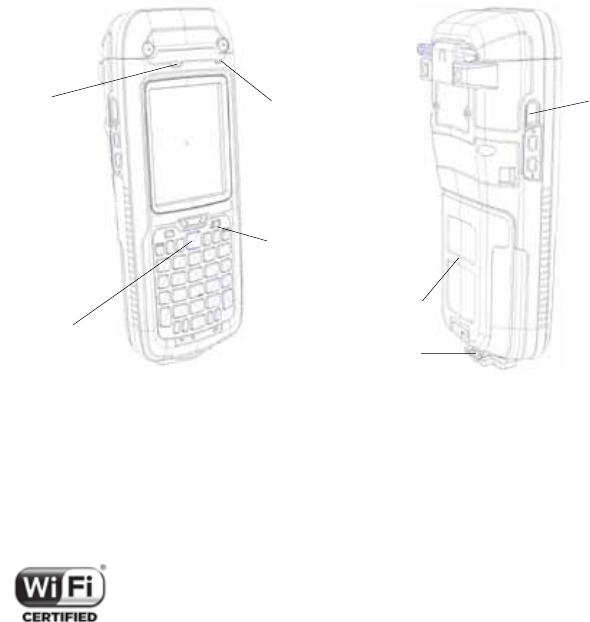
6 7
About the i�roc® Ci70 -Ex Mobile Computers
The ergonomically designed ecom instruments i.roc® Ci70 -Ex Mobile Computers are built on the
Microsoft Windows Embedded Handheld operating system. They are easy-to-use, and run most
software developed for the Windows Embedded platform, including standalone, client-server and
browser-based applications.
i�roc® Ci70 -Ex Front View i�roc® Ci70 -Ex Back View
Speaker
On/off button
Scan button
Battery
IrDa port
Overview of i�roc® Ci70 -Ex Features
The i.roc® Ci70 -Ex includes these standard features:
• Multi-processor architecture with 512 MB DRAM and 1GB Flash
• 802.11a/b/g/n and Bluetooth® radios
• Customer-accessible microSD slot for memory cards up to 32 GB
• IrDA port with speeds up to 4 Mbps
The i.roc® Ci70 -Ex Mobile Computer with an IEEE 802.11a/b/g/n radio
installed is Wi-Fi® certied for interoperability with other 802.11a/b/g/n
wireless LAN devices.
1
About the Computer Features
This chapter introduces the i.roc® Ci70 -Ex Mobile Computers with Windows® Embedded Hand-
held operating system. Use this chapter to learn about the basic features and functions of each
computer, as well as the available accessories for it.
Ambient light
Sensor
optional
Dust cover
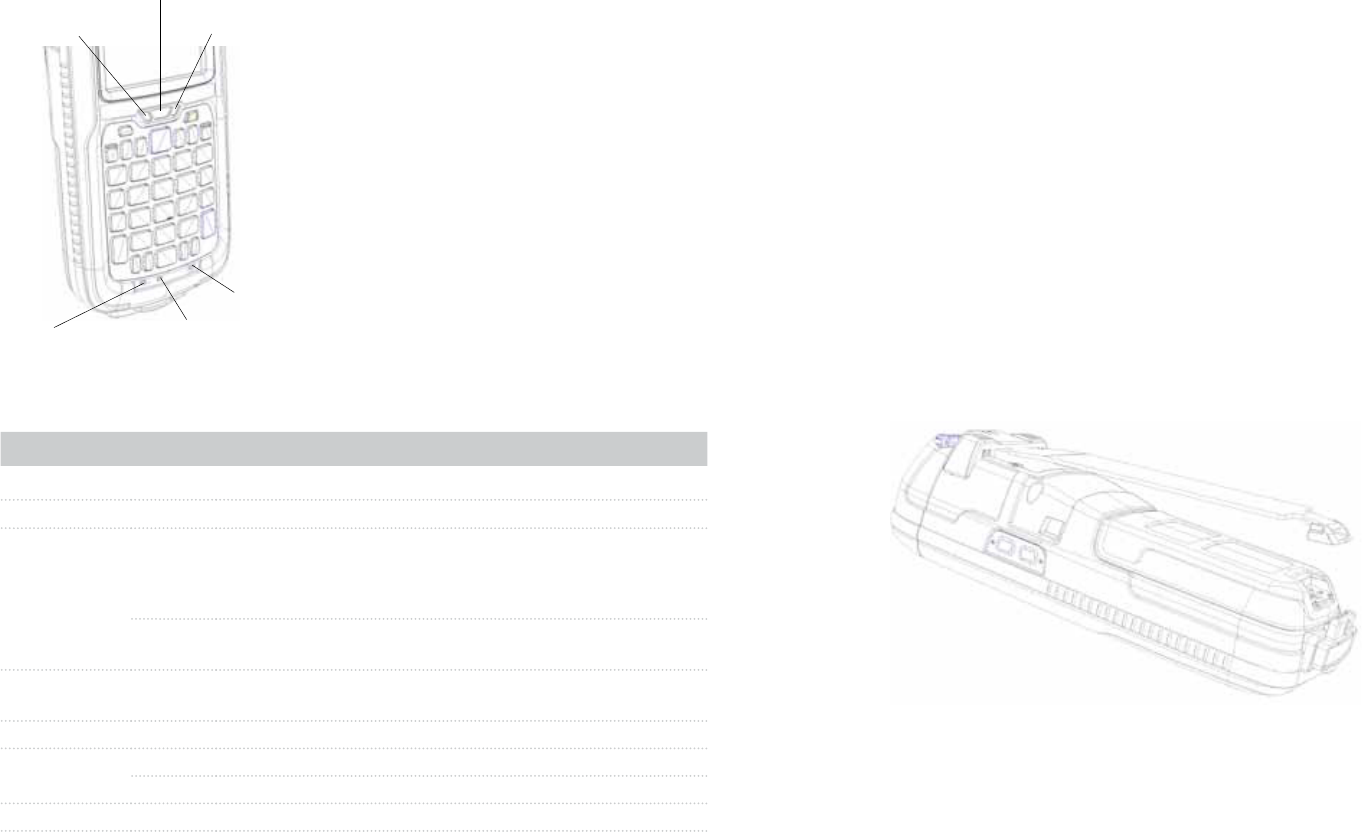
8 9
About Language Provisioning
If your i.roc® Ci70 -Ex computer includes language provisioning, you are prompted to select a
language provision when the computer starts for the rst time. It may take up to 15 minutes to load
your language.
Make sure you select the correct language before you tap Provision. If you need to have the lan-
guage provisioning changed, you will need to send your computer to an ecom instruments Global
Repair Center.
About the Battery L
The computer uses following rechargeable Lithium-ion battery pack as the main power source:
• 3.7 V, 4000 mAH (14.8 Wh) battery AM Ci70 -Ex
L
The battery used in this device may present a fire or chemical burn hazard if it is mistreated�
Do not disassemble it, heat it above 60 °C (140 °F) or incinerate it� Dispose of used batteries
promptly� Keep away from children�
Charge the Battery
You need to fully charge the battery before using your computer for the rst time.
Change the Battery
If your battery power is low, you need to either charge the battery in the computer, or replace it
with a charged battery.
1 Save your les and close any open applications.
2 Press the Power button and choose Shutdown from the menu to shut down the computer.
3 Detach the handstrap from the computer.
Detaching the Handstrap from on i�roc
®
Ci70 -Ex
4 Make sure the computer is in hibernate mode and that the screen has turned off.
5 Remove the battery.
Unscrew the battery‘s screw using enclosed screwdriver. Lift lower part of the battery to
release it from the computer.
About the Status LEDs
Use the following illustrations and table to understand the status LEDs on your computer. All six
status LEDS are not available on every i.roc® Ci70 -Ex computer. For example, the QWERTY ver-
sions of the i.roc® Ci70 -Ex do not have a Green key status LED.
Location of the i�roc® Ci70 -Ex Status LEDs
Green key
status LED
Shift key
status LED
Orange key
status LED
Battery status LED
Notication LED
Good Read and Ready-to-Work
Status LED
Status LED Descriptions
LED Color Description
Notication Amber This LED is user-programmable
Good Read Green The computer successfully decoded a bar code.
Ready-to-Work Blue If you have Intermec Terminal Emulator (ITE), the application is
running and connected to the host.
If you do not have ITE, you can congure the Ready-to-Work indi-
cator to turn on or off to indicate a healthy state.
Blinking
blue
ITE is running but not connected to the host.
The computer is unhealthy.
Off ITE is not installed or not running.
The computer is healthy.
Battery See “About Battery Status” on page 13.
Key Status Green The Green function key is enabled.
Orange The Orange function key is enabled.
Shift Red The Shift key is enabled.

10 11
Battery status LED
Battery status LED
Understanding the Battery Status LED
LED State Description
Steady green The computer is connected to a charger and the battery is more than 95%
charged.
Blinking red The battery is very low. The computer will soon go into Suspend mode.
Charge or replace the battery.
Steady red The computer is connected to a charger and the battery is charging.
Blinking red-amber The battery charging system has encountered an error. The battery is not
charging.
Steady amber The battery is outside of the allowable charging temperature range. Charg-
ing will resume when the battery temperature is back in the acceptable
range of 5 °C to 35 °C (41 °F to 95 °F).
Off The computer is not on external power and the battery is operating nor-
mally.
About Battery Life and Conservation
Batteries that are stored outside the computer for long periods of time slowly discharge. ecom
instruments recommends storing the battery in a charger to maintain battery performance.
Battery Conservation Tips
When You Want To: Do This to Save Battery Power:
Use the computer and the Low Battery
status icon appears or the Battery light
comes on.
• Connect the computer to an external power source.
• Or, save your data and press the Power button and
select Shutdown. After the computer turns off, remove
the battery and insert a fully charged battery.
Stop using the computer for 5 minutes
or longer.
Make sure that the low battery icon is not on the screen
and the Battery LED is not on. Press the Power button
and choose Suspend to suspend the computer.
6 Insert the top end of a fully charged battery into the computer, and press down rmly
on the bottom of the battery. Then tighten the screw. Make sure that the battery is rmly
attached.
About Battery Status
Use the battery icon on the Title bar to see the power status of your battery. If you want more de-
tailed information on your battery such as usage time or voltage, use the Intermec Dashboard. For
more information on the Dashboard see “About the Intermec Dashboard” on page 59.
Understanding the Battery Icon Status
Battery Icon Status
Battery is fully charged.
Battery has a high charge.
Battery has a medium charge. You should be able to work for several more hours before
changing batteries.
Battery is low. You need to charge or replace the battery soon.
Battery is critically low. You need to replace the battery now.
Battery is charging.
The battery is not installed.
You can also use the battery status LED to see the charging status of your battery.
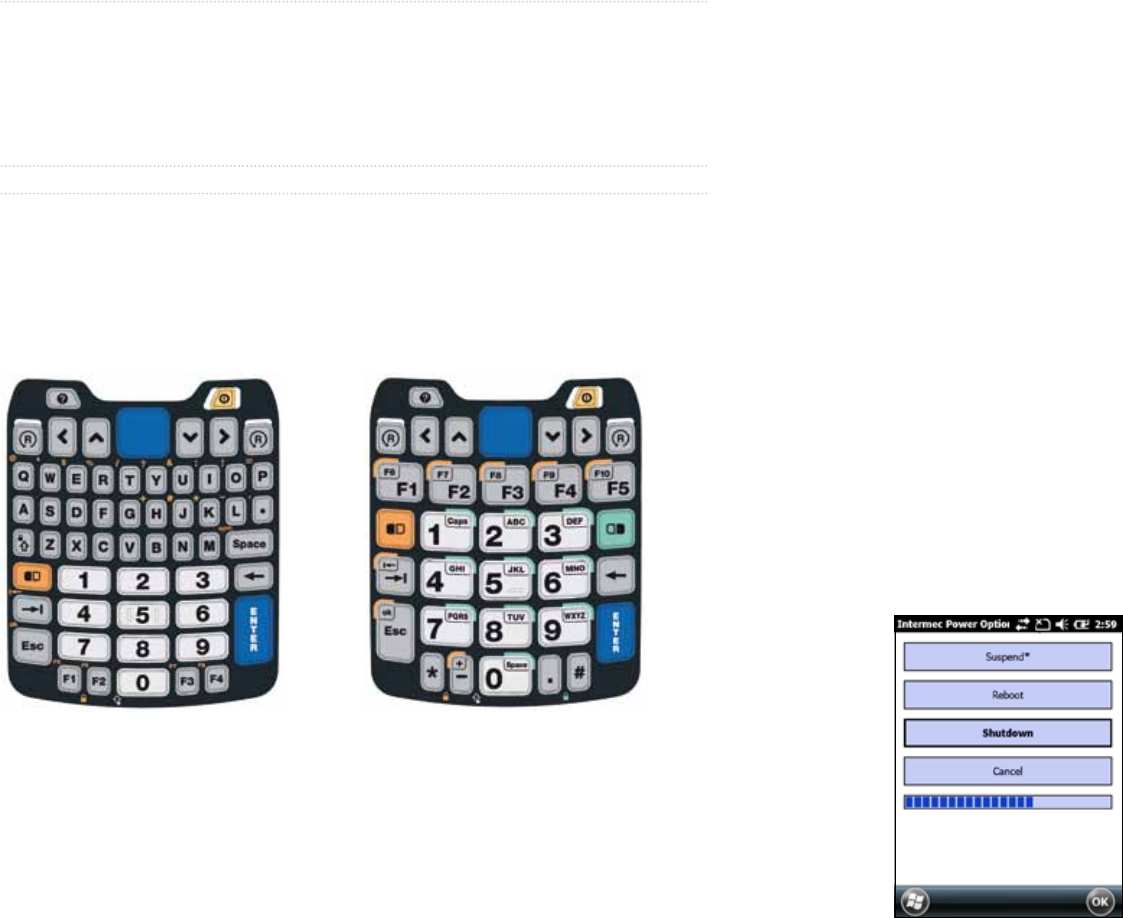
12 13
Enter Characters on the Numeric Keypad
You need to use the orange modier key b and the green modier key c to access all characters
and functions on the Numeric keypad.
To type a character or access a function printed in orange on the overlay:
• Press b and then press the key for the character or function.
To type a character or access a function printed in green on the overlay:
• Press c and then press the key for the character or function. To type letters in the upper
right corner of a key:
• Press c and then press the key one to three times depending on the position of the letter.
For example, in the upper right corner of the 2 key there are the letters „ABC”:
• To type „c“ press c 2 2 2.
• To type „C“ press c 1 and then press c 2 2 2.
To only type letters:
• Press c c to lock the green modier key, and then press the key one to four times depend-
ing on the position of the letter.
While the green modier key is locked, press 1 to toggle between only uppercase and lower-
case letters.
To unlock the green modier key, press c.
Note: If uppercase letters are enabled and you unlock the green modifier key, you may
need to press
c
1 to type lowercase letters�
About the Power Button
When you press the Power button, a dialog appears with a list of power options. If you do not
select a power options setting, the currently selected action (the button outlined in bold) occurs
after the timeout.
The Intermec Power Options Default Screen
Store the computer for more than a
day.
If you are storing the computer for a few days, like over
the weekend, install a charged battery or connect the
computer to a power source.
If you are storing the computer for longer, remove and
charge the battery, and then store both the battery and
computer in a cool location. If you store the battery for
several months, recharge the battery to keep it at peak
performance.
Store the battery outside the computer. Store the batteries in a charger.
About the Keypad
The i.roc® Ci70 -Ex comes with either a QWERTY numeric keypad or a numeric keypad.
The computer has an ambient light sensor that detects low light and turns on the keypad backlight.
By default, the keypad backlight is enabled in low light conditions. You can disable the keypad
backlight to conserve power. Use Intermec Settings to congure the backlight. For help, see “Use
Intermec Settings on the Computer” on page 35.
i�roc
®
Ci70 -Ex QWERTY Numeric Keypad i�roc
®
Ci70 -Ex Numeric Keypad
Enter Characters on the QWERTY Keypad
You need to use the orange modier key b and the Shift key y to access all characters and func-
tions on the QWERTY keypad.
To type a character:
• Press the key for that character.
To type a character or access a function
on the overlay:
• Press b and then press the key for the
character or function. To only type char
acters or access functions on the overlay:
• Press b twice to lock the orange modier
key to stay on, and then press the keys for
the characters or functions.
To type a single uppercase letter:
• Press y and then the letter key.
To type all uppercase letters:
• Press y y to turn on Caps Lock, and then
press the letter keys. You can still type
orange modier characters by pressing
b and then the key for that character.
To turn off Caps Lock, press y.

14 15
You can congure the screen backlight to turn off.
1 Tap Start > Settings > Power.
2 Tap Advanced on the horizontal scroll bar.
3 Select the screen power off settings for when the computer is on battery power or external
power.
You can congure the screen brightness using Intermec Settings or from the Start menu.
1 Tap Start > Settings > System > Backlight.
2 Adjust the slider to the desired brightness level.
3 Tap OK.
Adjust the Volume
You can adjust the computer volume for your needs and your environment. The volume includes
sounds you hear when you tap the screen or read bar codes with the imager. You can set the
volume to off, very low, low, medium, high or very high (default).
You can also use the buttons on the right side of the computer to adjust the volume:
• The upper button increases the volume.
• The lower button decreases the volume.
You can adjust the volume settings using Intermec Settings or the horizontal scroll menu.
1 Tap the Volume icon at the top of the screen, and then tap the volume icon on the
horizontal scroll menu.
2 Use your stylus or the u and d keys to adjust the volume slider to the volume you want, or
select Off.
Insert a microSD Card
You can use a microSD™ card to increase le storage and install software. The computers support
an optional 32 GB maximum capacity microSD card.
Note: The computer resets when you open the card access door to insert the microSD
card� Make sure you completely close the card access door before you use your
computer�
ecom instruments recommends using the following microSD cards:
Card Type Card Size ecom Part Number
ATP Industrial Grade microSD card 1 GB A0003477
ATP Industrial Grade microSD card 2 GB A0003478
ATP Industrial Grade microSD card 4 GB A0030305
ATP Industrial Grade microSD card 8 GB A0030306
Install a microSD card in a i�roc® Ci70 -Ex
1 Press the Power button to turn off the computer.
2 Remove the handstrap and the battery.
3 Remove the four Phillips screws and open the card access door.
Use the following table to understand the Intermec Power Options.
Note: The Real Time Clock (RTC) will persist through all of the power options as long as it
receives power from the Real Time Clock battery�
Intermec Power Options
Option Description
Suspend Medium power saving mode. The computer powers off all radios and internal
devices not involved in saving the system state, but the phone stays on to
receive calls. This option is the default setting. You can wake the computer by
pressing the Power button, pulling the scanner trigger, receiving a call, schedul-
ing an event such as an alarm, or by connecting external power.
Reboot The computer does not save the current system state, but the registry and
le systems are saved. The computer shuts down all running processes and
restarts.
Cancel The Power Options menu is cancelled.
Screen Off Lowest power saving mode. The screen turns off, but the phone, all radios, and
internal devices stay on. Tap the screen to turn the screen back on.
Shutdown Very high power saving mode. The computer turns off everything. You must
press Power or apply external power to restart the computer.
The Power Options screen is customizable. You can use Intermec Settings to determine which op-
tions are available to end users, the timeout until the default choice is selected, the default action
if no option is selected, or to disable the Power Options screen. For more information on custom-
izing the screen using ecom instruments Settings, see “Use Intermec Settings on the Computer” or
see the Intermec Settings Command Reference Manual.
About the Intermec Dashboard Button
If the Ready-to-Work light blinks, your computer may be experiencing a problem. Press the Inter-
mec Dashboard button (m) to launch the Intermec Dashboard application and view troubleshoot-
ing and status information.
You can press the m button at any time to bring up the Intermec Dashboard. If the computer is
not healthy, the current issues are displayed at the top of the screen. If the device is healthy, you
can use the Dashboard to view device information. For more information, see “About the Intermec
Dashboard”.
Configure the Screen Backlight
The display has an ambient light sensor that automatically adjusts the backlight intensity to con-
serve power and ensure the display is readable. By default, the screen turns off when there is no
activity with the computer. Press a key or tap the screen to resume activity.
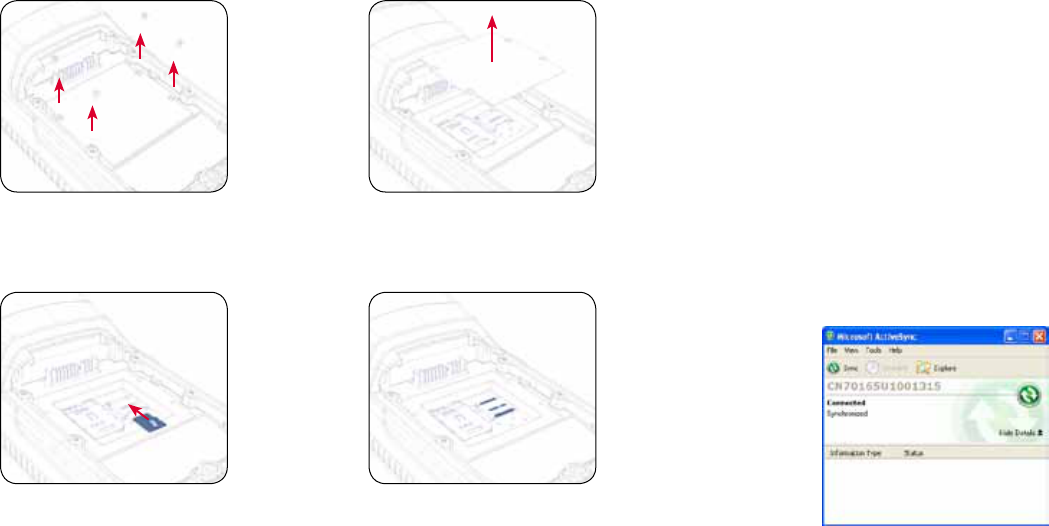
16 17
Use Microsoft ActiveSync to Transfer Files
You can use Microsoft ActiveSync (Windows XP or earlier) or Windows Mobile Device Center (Win-
dows Vista or Windows 7) to establish a connection between your computer and a PC. After you
connect to your PC, you can transfer les, synchronize les, remotely debug, and perform other
device management activities. ActiveSync and Windows Mobile Device Center are free applica-
tions available from the Microsoft website at www.windowsmobile.com/getstarted.
To establish a partnership between your computer and a PC, you need to physically connect your
computer to your PC using these accessories:
• ecom Single Dock Art.-No. AS030301 or
• Intermec Desktop Dock equipped with Ci70 computer cup
Using these accessories, you can transfer les to and from your PC using ActiveSync.
1 Connect your mobile computer to your desktop PC using the adapter and USB cable.
2 Download ActiveSync from the Microsoft website and install ActiveSync on your PC.
3 Follow the onscreen instructions to establish a partnership. When the partnership is
established, the Microsoft ActiveSync screen appears on your PC.
Use the Computer as a Mass Storage Device
You can connect the i.roc® Ci70 -Ex computer as a mass storage device to your desktop PC.
When connected as a mass storage device, you can easily copy les to and from the mobile
computer.
1 Go to www.datalight.com and download the Reliance Nitro Windows Driver (RNWD).
You will need to login before you can download the driver.
2 Connect the mobile computer to your desktop PC using a USB cable.
3 Open Intermec Settings on the mobile computer by tapping
Start > Settings > System > Intermec Settings.
4 From the Intermec Settings Main Menu, tap Device Settings > USB.
5 From the USB function driver menu, select Mass storage - Flash File Store and tap OK.
6 Copy les to and from your desktop PC to the mobile computer.
8 Close the SIM card door and slide it to the right to lock it in place.
9 Close the card access door. Then replace the cover plate and fasten the four screws.
10 Install the battery. Press down rmly on the bottom of the battery.
Then tighten the torx screw.
11 Reattach the handstrap.
12 Press the Power button. The computer cold boots.
Transfer Files To and From Your PC
The i.roc® Ci70 -Ex computer supports these two methods for transferring
les to and from your PC:
• Using Microsoft ActiveSync or Windows Mobile Device Center.
• Using the i.roc® Ci70 -Ex computer as a mass storage device.
4 Slide the SIM card door to the left to un-
lock it and open the door.
6 Slide the microSD card into place.
5 Slide the microSD card door towards the
top of the computer to unlock it and open
the door.
7 Close the microSD card door and slide it
towards the bottom of the computer to lock
it in place.
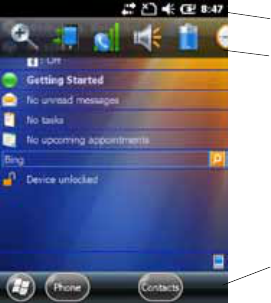
18 19
About the User Interface
The user interface for the Windows Embedded Handheld 6.5 operating system is different from
previous versions of Windows Mobile. The interface is touch-friendly and easy to navigate. Use the
following sections to understand how to interact with Windows Embedded Handheld 6.5.
About the Home Screen
When you turn on your mobile computer, the Home screen is the rst screen that appears. The
Home screen contains three navigation bars: the Title bar, the horizontal scroll bar, and the Tile bar.
The Windows Embedded Handheld 6�5 Home Screen
Tile bar
Title bar
Horizontal scroll bar
Use the Title bar icons to view the current status of information such as signal strength and battery
power remaining. For more information on the Title bar icons, see “Title Bar Status Icons” on page 40.
2
About the User Interface and
Intermec Applications
Use this chapter to learn about the Windows Embedded Handheld user interface and how to inter-
act with the screen. You can also use this chapter to learn about the ecom instruments applications
on your computer, as well as additional ecom instruments applications you can download.
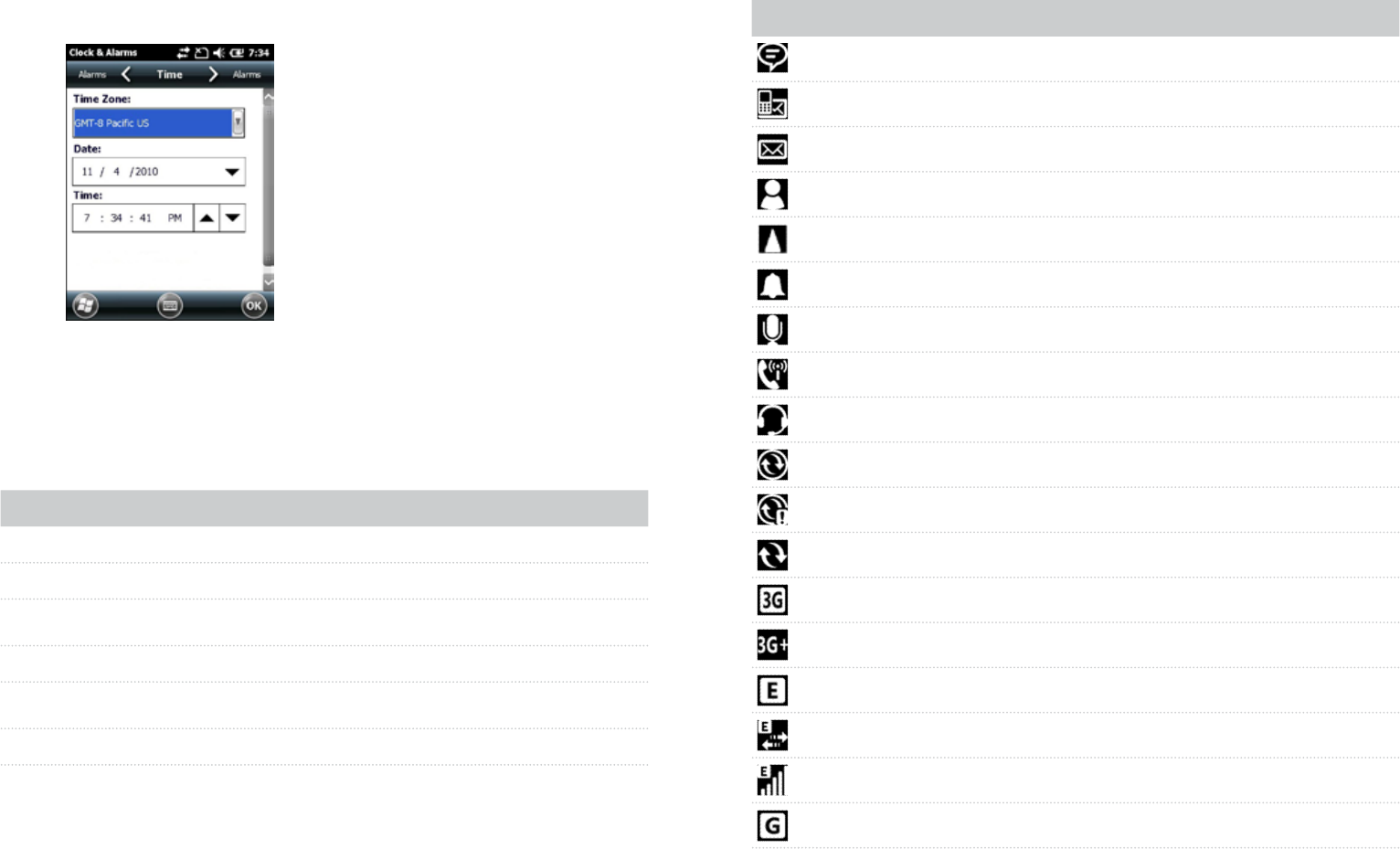
20 21
Title Bar Status Icons
Tappable icons in the Title bar immediately show you the status of your network, your phone, the
volume, the battery, and the time. Use the following table to understand what the icons mean.
Title Bar Status Icon Descriptions
Icon Description
You have a new notication.
You have a new text message.
You have a new email message.
You have a new instant message.
The WWAN module is roaming.
An alarm is set.
The microphone is on.
An internet call is in progress.
A Bluetooth headset is detected.
An ActiveSync connection has been established.
There is a problem with the ActiveSync synchronization.
An ActiveSync synchronization is in progress over USB.
A UMTS connection is active.
A 3G+ network is available.
An EDGE network is available.
Connecting to an EDGE network.
An EDGE connection is active.
A GPRS network is available.
A horizontal scroll bar appears when you tap an icon in the Title bar. This horizontal scroll bar makes
it easy to access the applications associated with the Tile bar icons. The horizontal scroll bar also
contains a magnier which improves the touch experience by making parts of the screen large
enough to tap with your nger.
The horizontal scroll bar also replaces tabs within Windows screens and allows for easier navigation.
Clock & Alarms Screen With Horizontal Scroll Bar
Use the Tile bar to navigate between screens and within applications.
The icons available on the Tile bar change depending on the application you are using.
Interact With the Screen
The Windows Embedded Handheld 6.5 interface supports the use of gestures with the nger or
stylus to move around the screen. The table below explains the supported gestures.
Gesture Description
Tap Represents the left click of a mouse.
Double-tap Represents the left double-click of a mouse.
Hold Represents the right click of a mouse when you press and hold on the screen
and a context menu appears.
Cancel The Power Options menu is cancelled.
Flick Initiates scrolling in the direction (horizontal or vertical) the nger or stylus
moves across the screen.
Pan Press and hold on the screen and then drag in any direction.

22 23
There is no SIM card present in the computer.
The volume is on.
The volume is off.
The battery has a full charge.
The battery has a high charge.
The battery has a medium charge.
The battery has a very low charge.
The battery is attached to external power and is charging.
No battery is installed in the computer.
GPS locator is off.
GPS locator is on.
Connecting to a GPRS network.
A GPRS connection is active.
An HSDPA network is available.
Connecting to an HSDPA network.
An HSDPA connection is active.
Bluetooth is on.
Wi-Fi is on but not connected, and no networks are detected.
Wi-Fi is not connected to a network, and other networks are
Other wireless networks are detected.
Connected to a wireless network.
Synchronizing through a Wi-Fi connection.
Connected to a wireless network, and other networks are detected.
Information about a new wireless network is available.
A network connection is active.
A network connection is inactive.
The WWAN module has maximum signal strength.
The WWAN module has no signal.
The WWAN module capability is off.
The WWAN module has no service.
The WWAN module is searching for service.
Data is being transferred.

24 25
Align the Screen
You may need to align your screen if you tap on one area and it registers in a different part of the
screen. Make sure you only use the stylus to complete the alignment process.
1 Tap Start (t) > Settings > System > Screen.
2 Follow the prompts on the screen to complete the alignment process.
About ecom instruments Applications
ecom instruments provides many useful applications to help you con gure, troubleshoot, and con-
nect your computer to other devices and networks. You can also download additional applications
from the ecom instruments website to help you use all of the features of your computer.
Applications Available on the Mobile Computer
Use this table to understand some of the Intermec applications available on your computer.
Intermec Applications Available on the Mobile Computer
Icon Application Description
Bluetooth
Audio
Use the Bluetooth Audio application to connect to a Bluetooth headset or
hands-free device. For more information, see Connect to a Bluetooth Audio
Device” on page 81.
iGPS
Use the iGPS application to improve the performance of GPS on your com-
puter. For more information, see Improve GPS Performance on the Comput-
er” on page 65. iGPS is only available on computers with phone capability.
ecom
Settings
Use ecom instruments Settings to con gure your computer. You can use
ecom instruments Settings to individually con gure a computer or you can
use it through SmartSystems to con gure all of your computers. For more in-
formation, see Use ecom instruments Settings on the Computer” on page 68.
ISpyWiFi Use ISpyWiFi to check your 802.11 status and diagnose issues with the con-
nection. For more information, see Check 802.11 Network Status” on page 109.
Pro le Set-
tings
Use Pro le Settings to easily con gure the computer for a speci c use. You
can choose prede ned values for the Camera, Power, and Scanning.
• Tap the Pro le Setting you want to use. You will see a message that chang-
es are saved and a check mark appears next to your choice. For more infor-
mation on modifying Pro le Settings options, see Con gure Pro le Settings
With ecom instruments Settings” on page 74.
ScanDiag-
nostic
Use the ScanDiagnostic application to troubleshoot problems with the inter-
nal or external scanner. For more information, see Use ScanDiagnostic to
Troubleshoot the Scanner” on page 112.
Wireless
Center
Use the Wireless Center to turn radios (Wi-Fi, Bluetooth, phone) on and off
and con gure settings for each radio.
Wireless
Printing
Use the Wireless Printing application to connect to a Bluetooth printer. For
more information, see Connect to a Bluetooth Printer” on page 80.
Wireless
Scanning
Use the Wireless Scanning application to connect to a Bluetooth scanner. For
more information, see Connect to a Bluetooth Scanner” on page 78.
Carrier
Selection
Use the Carrier Selection application to quickly change your network carrier.
For more information, see About Switching Network Carriers” on page 54.
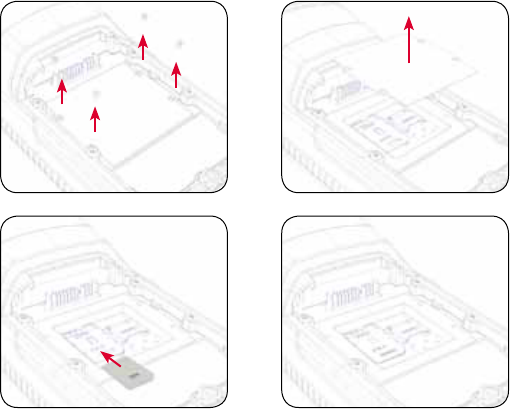
26 27
About the WWAN Module
The i.roc® Ci70 -Ex mobile computer supports two types of cellular technology:
• CDMA
• UMTS
Note: Your Flexible Network Radio mobile computer supports both CDMA and UMTS tech-
nology� Your Flexible Network Radio does not support Network Information and Time
Zone (NITZ) messages to automatically set the system time�
Cellular features on the computer include data connectivity. You can also use a Bluetooth headset
or hands-free kit for voice over IP (VoIP) applications.
After you turn on the WWAN module and activate service with your wireless carrier, you can cus-
tomize the WWAN features and network settings.
Activate the UMTS Module
You use a SIM card to activate the UMTS WWAN module on your computer. You can purchase the
SIM card from your network provider.
1 Press the Power button to turn off the computer.
2 Unscrew the battery’s screw using a torx scredriver. Lift lower part of the battery to release
it from the computer. Remove the four Phillips screws and open the card access door.
3 Slide the SIM card door to the left to unlock it and open the door.
4 Slide the SIM card into the slot in the card access door.
5 Close the SIM card door and slide it to the right to lock it in place.
6 Close the card access door. Then release cover plate and fasten the four screws.
7 Install the battery. Press down rmly on the bottom of the battery. Then tighten the
torx screw.
8 Press the Power button. The computer cold boots.
3
Use the WWAN Module
You can use the WWAN feature to transmit data through cellular wide-area networks (WANs).

28 29
4 Tap OK when you are done conguring the options.
5 Tap OK to close Wireless Center.
About Switching Network Carriers
Your Flexible Network Radio-enabled i.roc® Ci70 -Ex, or mobile computer contains a highly con-
gurable WWAN platform. When you switch network carriers, or perform a clean boot, you need to
set your cellular carrier, and your network connection.
Note: Your cellular carrier and network connection are set independently of each other�
If you select a cellular carrier that is not supported on your current network
connection, you must manually switch your network connection�
About the Network Connection
Note: When you perform a clean boot, the selected carrier will default to generic UMTS.
When you perform a clean boot, all user-created network connection entries are deleted, and only
the generic UMTS remains. After you perform a clean boot, you can nd more information about
generic UMTS by tapping Start > Settings > Connections > Connections > Tasks tab > Manage
Existing Connections > Modem tab.
Your UMTS connection entry can be automatically built from your carrier issued SIM card. To
automatically recreate your network connection, install your SIM card and tap Start > Settings >
Connections > Connections > Tasks tab > Automatically congure connection.
Switch Network Carriers
Use the Carrier Selection application to quickly change your WWAN radio network carrier on your
Flexible Network Radio-enabled i.roc® Ci70 -Ex, or mobile computer.
1 Tap Start > Settings > Personal > Carrier Selection.
2 From the Carrier drop-down menu, select the new carrier and tap OK. A dialog box
appears asking if you want to switch carriers.
3 Tap Yes to switch carriers.
If the update is successful, the Carrier Selection screen appears and displays the updated carrier
information. If the update is unsuccessful, a message box appears. Tap Ok to return to the Carrier
Selection screen. If you are switching to a CDMA network, or switching from a CDMA network to a
UMTS network, you must add the WWAN connection in ecom instruments Settings.
1 Tap Start > Settings > System > ecom instruments Settings > Communications >
WWAN Radio.
2 Select Add New WWAN Connection.
3 Enter a Connection Name. In the Phone Number eld, enter #777 and tap OK. The Manage
WWAN Radio State screen appears.
4 From Active Connection, select your Connection Name and Connect Now and tap OK.
Activate the CDMA Phone
To activate the CDMA radio module in your mobile computer, you need to contact your wireless
carrier and set up an account for each mobile computer. The following table lists the carriers that
ecom instruments currently supports. If your carrier is not listed in the table, please contact ecom
instruments product support to see if it is now supported.
Currently Supported Carriers
Country Carriers
United States Sprint, Verizon
The carrier will require the Mobile Equipment Identier (MEID) to start the activation process. You
can nd the MEID:
• on a label located in the upper right corner of the battery compartment.
• on the outside of the computer shipping box.
• in the Version Information menu.
Tap Start > Settings > Personal > Phone > Version Information tab.
The activation process is slightly different for each CDMA carrier. Your carrier sales contact and an
ecom instruments representative can guide you through the process.
After you supply the MEID to your carrier, they will respond with values that you must enter using
the Windows Mobile Activation Wizard (if required). Some of the supported carriers do not require
you to enter any values. The following table shows the carriers, the correct activation method to
use, and the values that you need to activate your phone.
Values Required for CDMA Phone
Carrier Activation Method Activation Values You Need
Sprint Activation Wizard
• Master Subsidy Lock (MSL) or activation code
• MDN
• MEID
Verizon • Dial *22899
• Activation Wizard
None. All parameters are automatically
transferred wirelessly.
After activation, the settings are permanently stored in the CDMA module. Changing the OS loads
will not affect any of the settings or activation parameters stored in the WAN modem.
Starting the Activation Wizard
Depending on your wireless carrier, you may need to use the Windows Mobile Activation Wizard to
activate your phone.
1 Tap Start > Phone, or tap the Phone button on the Tile bar. The phone application starts.
2 Tap Menu > Activation Wizard.
Turn the WWAN Module On and Off
Before you can start using your WWAN module, you need to enable it. You can use Wireless Center
to enable and disable your WWAN connectivity, as well as Bluetooth and Wi-Fi communications.
1 Tap Start > Settings > Connections > Wireless Center.
2 Tap Phone to turn on the WWAN module
3 (Optional) To congure the WWAN module, tap Menu in the tile bar at the bottom of the screen.

30 31
About the Integrated GPS on Your Computer
ecom instruments recommends that you use the GPS Intermediate Driver (GPSID) instead of
directly accessing the GPS hardware. The GPSID is a Microsoft software component that interacts
between applications and the GPS hardware.
As a Microsoft software component, the GPSID:
• allows multiple applications to simultaneously access the GPS data stream.
• provides access to GPS data without requiring applications to recognize and parse
NMEA syntax.
Use the GPSID Installed on the Computer
To use the GPSID installed on your mobile computer, you need to congure the GPSID settings.
1 Tap Start > Settings > System > External GPS. The GPS Settings screen appears with
Programs selected.
2 Select the COM port that you want your programs to use to get GPS data from your
computer.
3 Tap Access in the horizontal scroll bar and select the Manage GPS automatically
check box.
4 Tap OK.
4
Use GPS
When equipped with an optional WWAN module i.roc® Ci70 -Ex computer comes equipped with
an integrated Global Positioning System (GPS). The GPS receiver can deliver standards-based
National Marine Electronics Association (NMEA) data strings to GPS applications.
32 33
Improve GPS Performance on the Computer
Use the iGPS application to improve the performance of the GPS on your i.roc® Ci70 -Ex com-
puter. The integrated GPS module has three operating modes:
• Standalone
• MS Assisted (Mobile Station Assisted)
• gpsOneXTRA™ (WWAN computers only)
In Standalone mode, the GPS module relies solely on GPS satellites to determine position.
In MS Assisted mode, the computer can determine position without receiving GPS signals directly
from satellites; instead, the computer receives GPS signals and information provided by the cellular
network. Even when the computer can receive a satellite signal, MS Assisted can improve position
accuracy and reduce the time to determine initial position (Time-To-First-Fix). Check with your cell
phone carrier for availability and pricing for MS Assisted service.
Qualcomm’s gpsOneXTRA Assistance technology provides enhanced operation for Standalone
GPS. This option enables the UMTS-enabled computer to automatically download a small assis-
tance data le from the XTRA servers through a brief internet access session. To use this option,
you must have a valid and activated WAN data connection.
Note: Internet connection fees may apply�
Another option you can congure with iGPS is the x interval. The x interval denes how often
the GPS should provide new information. Larger intervals use less power, but many applications
require small intervals to work correctly. The default for x interval, in seconds, is 4. The Flexible
Network Radio has a maximum interval of 4.
Note: Anytime you change the GPS settings, the phone module automatically resets�
It will not affect the functionality of the computer�
To improve GPS performance:
1 Go to Start > Settings > System > iGPS.
2 In the Fix Interval tab, enter a value for the x interval. The default setting is 4 and should
be optimized for most applications.
3 Tap the Fix Type tab and select one of these options: Standalone (1), MS assisted (2), or
Enable gpsOneXTRA (check box).
4 Tap OK.
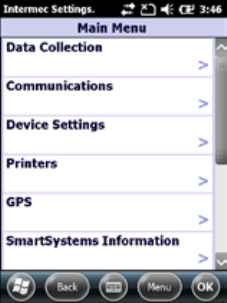
34 35
How to Configure the Computer
You can congure many parameters on the computer such as the bar code symbologies it
decodes or the network settings. The values you set for these parameters determine how the
computer operates.
There are several ways to congure the computer:
• Directly on the computer. You can use Intermec Settings directly on the computer to
change only the settings on that computer. For more information, see the next section,
“Use Intermec Settings on the Computer.”
• Remotely using Intermec SmartSystems Foundation. When you use SmartSystems, you
can remotely congure all of your i.roc® Ci70 -Ex mobile computers as well as other
SmartSystems-enabled Intermec computers and peripherals. For more information, see
“Use Intermec Settings Remotely With SmartSystems Foundation” on page 76.
• You can use a third-party device management product that supports the computer and
Intermec Settings, such as Soti MobiControl or Wavelink Avalanche. For more information,
visit the Device Management page on the Intermec website.
You can also congure the computer with conguration bundles that you create using
SmartSystems Foundation. For more information, see the SmartSystems Foundation Online
Help.
Use Intermec Settings on the Computer
Use Intermec Settings to congure parameters for ecom instruments applications on the computer
as well as some device-specic parameters like volume. You can congure parameters for impor-
tant functions like data collection and communications.
Start Intermec Settings
Intermec Settings is located on the System screen.
• Tap Start > Settings > System > Intermec Settings. The Intermec Settings Main Menu
appears.
About the Structure of Intermec Settings
Use the tables below to help nd the parameters in Intermec Settings that you want to congure.
Each table contains the parameters for one of the Intermec Settings Main Menu options.
5
Configure the computer
Use this chapter to learn about the available methods for conguring your mobile computer and
how to use ecom instruments Settings. You can also use this chapter to learn how to congure
network communications and wireless security.

36 37
Prole Settings Application • Power
• Scanning
Screen • Screen rotation Sensor
Sounds Volume settings
System Component Versions System component versions (Read-only)
USB USB connections
Printers Menu
Printers Options Parameters You Can Configure
Printer (if connected through Blue-
tooth)
Printer settings (auto detect printer, memory, display etc.)
Note: The Printer menu displays settings for the Bluetooth connected printers�
The settings that appear in the menu are dependent on the printer that is
paired with the device� The printer needs to be using the Wireless Printer applet�
Core Messaging Menu
Core Messaging Options Parameters You Can Configure
Servier IP Server IP (read-only)
Associated Server IP Associated Server IP
Broadcast Name Broadcast name
Port Port (read-only)
Keep Alive Ping Interval Keep alive ping interval
Smart Systems Information Menu
Smart Systems Information Options Parameters You Can Configure
Identity Identity information (hardware version, rmware version,
OS version etc.) (read-only)
Administrator Administrator settings (name, phone and e-mail)
Location Location settings (country, state, city, campus, detail)
Information Device notes (read-only)
If you see > next to a menu option, there are more screens available in the next level. If you see ...
next to a menu option, there is only one more screen available.
Most parameters are saved as soon as you tap OK. Some settings such as the Serial Port Switch
require you to reboot the computer for the changes to take effect.
Bluetooth Scanners Settings
Communications Menu
Communications Options Parameters You Can Configure
Device Name Device Name
802.11 Radio • Radio Enabled
• Security Choice
• Funk Security
• IP Settings
• Certicates
• Allow Security Changes
Ethernet Adapter • Not user accessible
Bluetooth Bluetooth settings (power,discoverable, connectable etc.)
WWAN Radio • Add new WWAN Connection
• Edit WWAN Connections
• Manage WWAN Radio State
• Carrier Selection
• WWAN Information
Device Settings Menu
Device Settings Options Parameters You Can Configure
Backlight Backlight settings (display backlight, keypad backlight,
light level)
Date and Time Date and time settings
Features Disabled by Policy None (read-only)
Good Read • Bluetooth Scanner
• RFID Scanner
• Internal scanner
• Dock tethered scanner
IDL Runtime Versions Read-only
Keypad Handle trigger
Scan button remapping
Power Management • Power button
• Battery power
• External power
• Device off sensor

38 39
Navigate in Intermec Settings
You can easily navigate through the screens in ecom instruments Settings to nd the parameter
you need to congure.
To move down a level in Intermec Settings:
• Tap the menu item in the list.
To move back a level in Intermec Settings:
• Tap Back or Cancel on the Tile bar.
To save a parameter setting:
• Tap OK.
To exit Intermec Settings:
• Tap Menu > Exit or OK.
Configure Profile Settings With Intermec Settings
A prole is a set of predened values that you can easily apply to the computer to ensure optimal
performance in a specic scenario. The end user does not need to gure out the right” settings
because we have already done that work for you. Prole Settings is available from the Start menu
so you can make it available to the end user for easy conguration.
Use ecom instruments Settings to determine the proles you want the end user to see in the Prole
Settings application.
1 Go to Device Settings > Prole Settings Application.
2 Select Camera, Power, or Scanning.
3 From the Camera, Power, or Scanning submenu, check or clear the Display check box for
the settings you want to have available to the end user.
4 Click OK to save your selection.
Restore Default Settings
You can easily restore a menu to its default settings or all of the
ecom instruments Settings parameters to their default settings if necessary.
1 Navigate to the menu that you want to restore to defaults.
2 Tap Menu > Restore Menu Defaults.
3 When prompted, tap Yes to restore the menu default settings.
4 If prompted to refresh the computer, tap Yes.
You can restore defaults settings for all parameters.
1 Tap Menu > Restore All Defaults. The applications asks if you are sure you want to restore
all defaults.
2 Tap Yes.
After several minutes, all of the default settings are restored.
Hide Menu Items in Intermec Settings
You can hide items in the Intermec Settings menus if you do not want to have them available for
other users to access. Hidden items are not saved when you back up your settings in the Smart-
Systems console.
On the mobile computer, you can:
• hide menu items by tapping and holding the item, and then choosing Hide Menu Item from
Device Monitor Menu
Device Monitor Options Parameters You Can Configure
Device Health Controls • Enable health data collection
• Enable device health appication
• Enable blue light (LED)
• Set rule le location
• Set data refresh periods
Device Health Secreen Captures Device health sceeen capture settings (directory and
screen capture allowed)
Disabled Executables None (read-only)
Device Wipe Device wipe settings (enable wipe and interval)
License Manager Menu
License Manager Options Parameters You Can Configure
About About settings (read-only)
License Vault None (displays applicaitions that are licensed)
Head Module settings • Enable Modules
• Setup Modules
Virtual Wedge Menu
Virtual Wedge Options Parameters You Can Configure
Enable Virtual Wedge Enable virtual wedge
Virtual Wege Method Set virtual wedge method
Barcode Scanner Wedge Bar code scanner wedge settings (bar code scanner grid
and label encoding)
Magstripe Reader Wedge Magstripe Reader Grid
Location Services Menu
Location Services Options Parameters You Can Configure
Server Server settings (port and anable server)
Virtual GPS Virtual GPS settings

40 41
Configure Bluetooth Communications
Your mobile computer is Bluetooth™-enabled, which lets you connect to other Bluetooth devices,
such as scanners, printers, or audio devices. You need to turn on the Bluetooth radio before you
can discover and connect to other Bluetooth devices. By default, the radio is turned off. You can
congure Bluetooth communications using Intermec Settings or from the Start menu.
1 Tap Start > Settings > Intermec Settings > Communications >
Bluetooth.
2 Select the Turn on Bluetooth check box.
3 (Optional) If you want your computer to be visible to other
Bluetooth devices, choose “Discoverable”.
4 Tap OK.
The Bluetooth radio maintains its state through a reboot or cold boot and maintains virtual COM
ports. But, if you clean boot your computer you need to recreate pairings to devices.
Connect to a Bluetooth Scanner
You can connect the computer to an Intermec Bluetooth scanner, such as the SF51 or SR61.
1 Tap Start > Settings > System > Wireless Scanning.
2 Tap Add Device.
the popup list. When asked if you want to hide the menu, tap Yes.
• restore all hidden items in all menus, by tapping Menu > Unhide All Items.
Note: When you restore default settings in ecom instruments Settings, only the
settings for visible items are restored to defaults� The settings for hidden menu
items are not affected�
Use Intermec Settings Remotely With
SmartSystems Foundation
Your mobile computer is SmartSystems-enabled, which lets you open ecom instruments Settings
from the SmartSystems console to remotely congure all of your mobile computers. For more infor-
mation on SmartSystems, see Manage the Computer Using SmartSystems Foundation” on page 98.
1 In the SmartSystems console, select a mobile computer and right-click.
2 From the menu, select Intermec Settings.
3 Congure the settings you need to change. As you choose parameters from the tree
structure, help for each parameter appears in the upper right pane of Intermec Settings.
4 When you are done making changes, choose File > Save Settings.
For help using Intermec Settings, click Help > Contents. For information on all of the parameters in
Intermec Settings, see the Intermec Settings Command Reference Manual.
About Network Communications
You can easily add the mobile computer to your wireless or wired data collection network. You can
connect your computer using:
• 802.11a/b/g/n radio communications.
• Ethernet communications.
• Bluetooth communications.
• USB and serial communications.
Configure 802�11a/b/g/n (Wi-Fi) Radio Communications
L Make sure all components with antennas are at least 30 cm (1 ft) apart when power is
Caution applied. Failure to comply could result in equipment damage.
The mobile computer contains an 802.11 radio to transfer data using wireless communications and
to support the TCP/IP network protocols. This section of the manual assumes that your wireless
network is set up, including your access points. By default, the 802.11 radio is disabled. Use the
following procedure to enable the Wi-Fi radio using Intermec Settings. If you would like to use
ScanNGo bar codes to easily enable the radio and set the default security settings, see Appendix
C ScanNGo Wi-Fi Conguration Bar Codes” on page 167.
1 Tap Start > Settings > System > Intermec Settings.
2 From the Intermec Settings main menu, tap Communications > 802.11 Radio >
Radio Enabled.
3 Select the Radio Enabled check box and tap OK. By default, the computer uses Funk
security and enables DHCP.
4 Use Intermec Settings to congure any other parameters you need to use for
communication with your network.
5 Congure 802.11 security. For help, see About Wireless Security” on page 85.
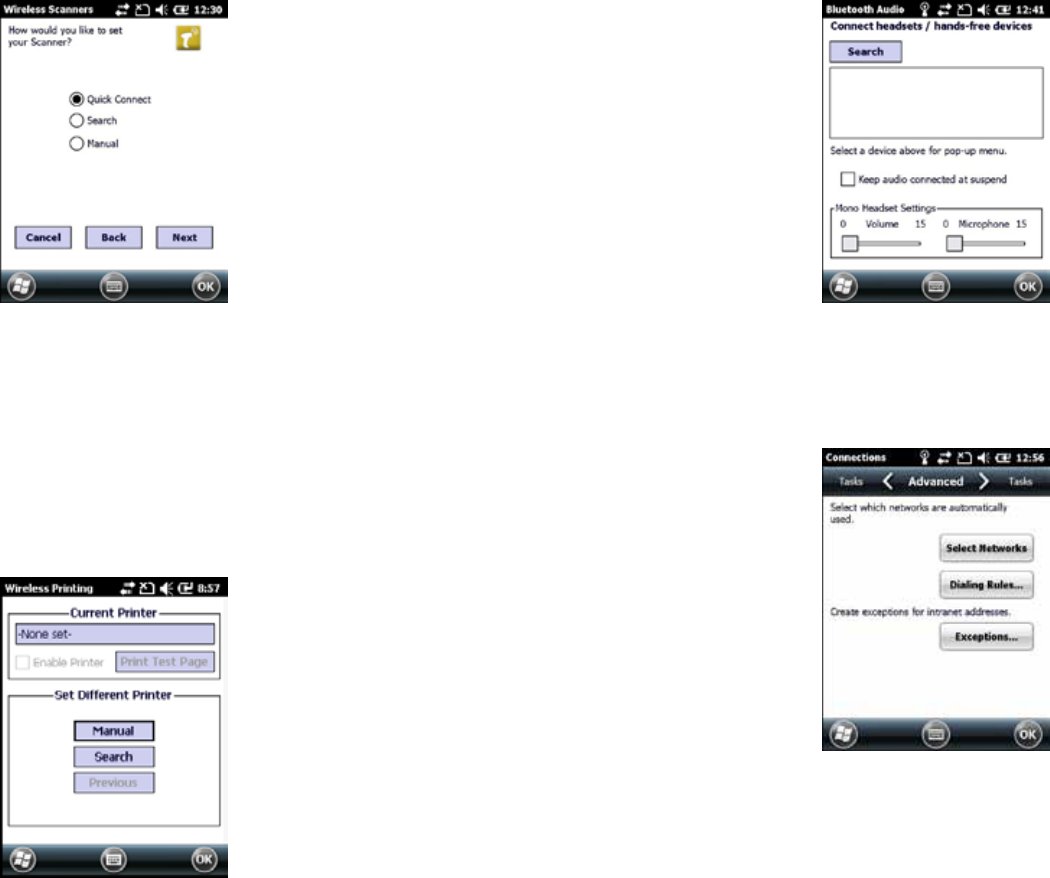
42 43
1 Tap Start > Settings > System > Bluetooth Audio.
2 Tap Search to nd your Bluetooth headset or hands-free
device.
3 Select your device from the list and congure any settings.
4 Click OK when you are done.
Create an ISP Connection
You can create an Internet Service Provider (ISP) connection to send and receive email messages
using Messaging (Outlook Email) and view web pages using Internet Explorer Mobile. You need to
get your ISP dial-up access telephone number, a user name, and a password from your ISP.
1 Tap Start > Settings > Connections > Connections.
2 Under My ISP, tap Add a new modem connection.
3 Enter a name for the connection, such as ISP Connection.”
4 If you are using an external modem connected to your mobile
computer with a cable, select Hayes Compatible on COM1
from the Select a modem list.
5 Tap Next.
6 Enter the access phone number and then tap Next.
7 Enter the User name, Password, and Domain (if provided by
an ISP or your network administrator).
8 Tap Finish.
9 On the Connections screen, tap Advanced on the horizontal
scroll.
10 Tap Dialing Rules.
11 When the Enable Dialing Rules box appears, tap OK.
12 Tap Edit.
13 In the Name eld, enter your phone type
(Home, Mobile, or Work).
14 Tap OK until you exit the Connections screen.
3 Select Quick Connect, Search, or Manual. Follow the onscreen
instruction to add a wireless scanner.
Connect to a Bluetooth Printer
To congure your computer for Bluetooth wireless printing, you need to:
• create an application that opens the wireless printing COM port on your computer. For
help, see the Bluetooth Resource Kit, which is part of the ecom instruments Developer Library
(IDL), available from the ecom instruments website at www.intermec.com/idl.
• select the current wireless printer on your computer. For help, see the next procedure.
Note: You can also print wirelessly using Microsoft APIs with Bluetooth extensions for
Winsock and Bluetooth virtual COM ports� For help, see the Bluetooth Resource
Kit documentation�
1 Tap Start > Settings > System > Wireless Printing.
2 Tap Search to nd a printer, or tap Manual to enter a device ad
dress. Follow the onscreen instructions to select the current
wireless printer.
3 (Optional) Tap Print Test Page. The printer prints out a test
page.
Connect to a Bluetooth Audio Device
Use the Bluetooth Audio enabler to discover, activate, and connect to Bluetooth audio devices
such as a headset. This enables system sounds to be monitored through the headset.
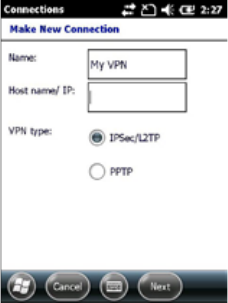
44 45
Choose Between Microsoft and Funk Security
The computer supports both Funk and Microsoft security, which dynamically select wireless
networks based on your preferences. The option you choose depends on your network security
needs.
• If you are using the computer in a static environment that requires a high level of security,
you should use Funk security, which offers CCX v4.0 compliance, support for LEAP and TTLS,
and conguration for up to four proles. To use Funk security, you need to select a prole. For
help, see the next section, Select a Funk Security Prole.”
• If you are primarily using the computer to connect to Wi-Fi hotspots, you may want to use
Microsoft security. To use Microsoft security, you need to select it as your security choice. For
help, see Select Microsoft as Your Security Choice” on page 90.
Select a Funk Security Profile
You can dene up to four proles for Funk security. Different proles let your computer communi-
cate in different networks without having to change all of your security settings. For example, you
may want to set up one prole for the manufacturing oor and one for the warehouse. By default,
the active prole is Prole 1.
Select a Funk Security Profile
Use the following procedure to select a Funk security prole.
1 Start ecom instruments Settings.
2 Choose Communications > 802.11 Radio > Funk Security.
3 Choose a prole. A list of congurable settings appears.
4 (Optional) In the Prole Label text box, enter a meaningful name for your prole.
5 Congure your security settings. For help, see the next sections.
6 Repeat Steps 3 through 5 for each prole you want to dene.
7 Set an active prole by choosing it in the Active Prole list.
8 Save your settings.
Configure WPA or WPA2 Enterprise (802�1x) Security With Funk
Use these procedures to set WPA-802.1x or WPA2-802.1x security on your computer with Funk
security.
1 Make sure the communications and radio parameters on your 70 Series are congured.
2 Make sure Funk is selected as your security choice.
3 Start ecom instruments Settings.
4 Choose Communications > 802.11 Radio > Funk Security.
5 Select the prole you want to congure.
6 For Association, choose WPA or WPA2. Encryption automatically defaults to TKIP or AES,
respectively.
7 For 8021x, choose TTLS, PEAP, EAP-FAST, or TLS.
8 If you choose TTLS, EAP-FAST, or PEAP:
a For Prompt for Credentials, choose Enter credentials now.
b Enter a User Name and User Password.
c For Validate Server Certicate, choose Yes.
Note: The correct date must be set on your computer when you enable Validate
Server Certificate�
Create a VPN Server Connection
You can create a Virtual Private Network (VPN) connection to securely connect to servers, such as
a corporate network, through the Internet. Before you can create a VPN connection, you need this
information from your network administrator:
• User name
• Password
• Domain name
• TCP/IP settings
• Host name or IP address of the VPN server
After you have located this information, you can create a VPN server connection.
1 Tap Start > Settings > Connections > Connections.
2 Under My Work Network, tap Add a new VPN server
connection.
3 Step through the screens to set up your VPN connection.
About Wireless Security
The computer provides ve types of security for your wireless network:
• Wi-Fi Protected Access 2 (WPA2™)
• Wi-Fi Protected Access (WPA)
• 802.1x
• LEAP
• WEP
This section explains how to congure wireless security on your mobile computer. ecom instru-
ments recommends that you implement WPA2 security using PSK (Personal) or 802.1X (Enter-
prise) key management as appropriate.
You must use either Funk or Microsoft security to implement your security solution. For details,
see the next section, Choose Between Microsoft and Funk Security.” ecom instruments recom-
mends that you always implement WPA2 security using PSK (Personal) or 802.1X (Enterprise) key
management.
If you are using WPA-802.1x, WPA2-802.1x, or 802.1x security, this section also assumes that your
authentication server and authenticators are properly congured.
Note: Your security choice does not depend on your authentication server�
For example, you can choose Funk security if you use Microsoft Active Directory®
to issue certificates�
46 47
2 Choose Communications > 802.11 Radio > Funk.
3 Select the prole you want to congure.
4 For 8021x, choose LEAP.
5 For Association, choose Open, WPA, WPA2, or Network EAP. Encryption automatically
defaults to TKIP if you choose WPA, AES if you choose WPA2, and WEP if you choose
Open or Network EAP.
6 For Prompt for Credentials, choose Enter credentials now.
7 Enter a User Name and User Password.
8 Save your settings.
Configure Static WEP Security With Funk Security
Use the following procedure to congure static WEP security with Funk. ecom instruments recom-
mends that you use WPA2-PSK instead of WEP if possible.
1 Make sure the communications and radio parameters on your computer are congured.
2 Make sure Funk is selected as your security choice.
3 Start ecom instruments Settings.
4 Choose Communications > 802.11 Radio > Funk Security.
5 Select the prole you want to congure.
6 For Association, choose Open.
7 For Encryption, choose WEP.
8 For 8021x choose None.
9 Dene a value for the keys you want to use. You can dene up to four keys (Key 1 through
Key 4). Enter an ASCII key or a hex key that is either 5 bytes or 13 bytes long depending
on the capability of the radio. Set a 5- byte value for 64-bit WEP or a 13-byte value for
128-bit WEP. Hex keys must be preceded by 0x and contain 5 or 13 hex pairs.
10 For Transmit key, choose the key you want to use for transmitting data.
11 Save your settings.
Use Open (No Security) Associations with Funk
Use the following procedure to congure your mobile computer for open security using Funk.
1 Start ecom instruments Settings.
2 Choose Communications > 802.11 Radio > Funk Security.
3 Select the active prole you are using.
4 For Association, choose Open.
5 For Encryption, choose None.
6 Tap OK. Your settings are saved.
Select Microsoft as Your Security Choice
The default security setting is Funk. If you want to use Microsoft Wireless Zero Conguration (WZC)
security, you need to select it as your security choice. After you select Microsoft as your security
choice, you will be prompted to save your settings and reset the computer for your change to take
effect.
With Microsoft as your security choice, you can congure:
• WPA or WPA2
• 802.1x
• Static WEP
9 If you choose TLS:
a Load a user and root certicate on your computer. For help, see Load a Certicate”
on page 95.
b Enter a User Name and Subject Name.
c For Validate Server Certicate, choose Yes.
Configure WPA or WPA2 Personal (PSK) Security With Funk
Use the following procedure to congure WPA-PSK or WPA2-PSK with Funk security.
1 Make sure the communications and radio parameters on your computer are congured.
2 Make sure Funk is selected as your security choice.
3 Start ecom instruments Settings.
4 Choose Communications > 802.11 Radio > Funk Security.
5 Select the prole you want to congure.
6 For Association, choose WPA or WPA2.
7 For 8021x, choose None.
8 For Pre-Shared Key, enter the pre-shared key or passphrase. The pre-shared key must be
a value of 32 hex pairs preceded by 0x for a total of 66 characters. The value must match
the key value on the access point. The passphrase must be from 8 to 63 characters. After
you enter a passphrase, the i.roc® Ci70 -Ex internally converts it to a pre-shared key. This
value must match the passphrase on the authenticator.
9 Save your settings.
Configure 802�1x Security With Funk Security
Use the following procedure to congure 802.1x-WEP security with Funk security. ecom instru-
ments recommends that you use WPA2-802.1x instead of 802.1x-WEP if possible.
1 Make sure the communications and radio parameters on your computer are congured.
2 Make sure Funk is selected as your security choice.
3 Start ecom instruments Settings.
4 Choose Communications > 802.11 Radio > Funk Security.
5 Select the prole you want to congure.
6 For Association, choose Open.
7 For Encryption, choose WEP.
8 For 8021x, choose TTLS, PEAP, or TLS.
9 If you chose TTLS or PEAP:
a Enter a User Name.
b For Prompt for Credentials, choose Enter credentials now.
c Enter a User Password.
d For Validate Server Certicate, choose Yes.
10 If you choose TLS:
a Load a user and root certicate on your computer. For help, see Load a Certicate”
on page 95.
b For Validate Server Certicate, choose Yes.
c Enter a User Name and Subject Name.
11 Save your settings.
Configure LEAP Security With Funk
After you congure the communications and radio parameters on your mobile computer and select
Funk as your security choice, you can congure LEAP.
1 Start ecom instruments Settings.
48 49
Configure 802�1x Security with Microsoft
Use the following procedure to congure 802.1x security with Microsoft security. ecom instruments
recommends that you use WPA2-802.1x instead of 802.1x-WEP if possible.
1 Make sure the communications and radio parameters on your computer are congured.
2 Start ecom instruments Settings.
3 Choose Communications > 802.11 Radio > Microsoft Security.
4 For Infrastructure Mode, choose Infrastructure.
5 For Network Authentication, choose Open.
6 For Data Encryption, choose WEP.
7 For 802.1X Authentication, choose TLS or PEAP.
8 If you choose TLS:
a Load a user and root certicate on your computer. For help, see Load a Certicate”
on page 95.
b Choose Properties. The Certicates dialog box appears.
c Select the certicate you want to use from the list. The User Logon dialog box appears.
d Enter a User Name and Domain and tap OK.
e Tap OK to exit the Certicates dialog box.
f Press OK to save the Microsoft Security settings.
9 If you choose PEAP:
a Load a root certicate of the authentication server on your computer. For help, see Load a
Certicate” on page 95.
b Press OK to save the security settings and the User Logon dialog box appears.
c Enter a User Name, Password, and Domain. Select Save Password if you want to save the
password for future authentication sessions.
d Press OK to save the Microsoft Security settings.
10 For Network Key Setting, choose Automatic.
11 Save your settings.
Configure Static WEP Security With Microsoft
Use the following procedure to congure static WEP security with Microsoft security. ecom instru-
ments recommends that you use WPA2-PSK instead of WEP if possible.
1 Make sure the communications and radio parameters on your computer are congured.
2 Start ecom instruments Settings.
3 Choose Communications > 802.11 Radio > Microsoft Security.
4 For Network Authentication, choose Open.
5 For Data Encryption, choose WEP.
6 For Network Key Setting, choose Enter Key and Index.
7 For Network Key Value, enter an ASCII key or a hex key that is either 5 bytes or 13 bytes
long depending on the capability of the radio. Set a 5-byte value for 64-bit WEP or a
13-byte value for 128-bit WEP. Hex keys must be preceded by 0x and contain 5 or 13 hex
pairs.
8 For Network Key Index, select the key you want to use for data transmission.
9 Save your settings.
Use Open (No Security) Associations With Microsoft
Use the following procedure to congure your mobile computer for open security using Microsoft
WZC.
1 Start ecom instruments Settings.
2 Choose Communications > 802.11 Radio > Microsoft Security.
Select Microsoft Security
Use the following procedure to select Microsoft security.
1 Start ecom instruments Settings. For help, see Congure the Computer” on page 67.
2 Choose Communications > 802.11 Radio > Security Choice.
3 From the Security Choice list, select Microsoft Security. An alert box appears telling you
that you must save your settings and reboot the computer for the new security choice to
take effect.
4 Choose Yes. The computer resets and starts with Microsoft Security as the Security Choice.
Configure WPA or WPA2 Enterprise (802�1x) Security With Microsoft
Use these procedures to set WPA-802.1x security on your computer with Microsoft security.
1 Make sure the communications and radio parameters on your computer are congured.
2 Start ecom instruments Settings.
3 Choose Communications > 802.11 Radio > Microsoft Security.
4 For Infrastructure Mode, choose Infrastructure.
5 For Network Authentication, choose WPA or WPA2. Data Encryption automatically defaults
to TKIP for WPA and AES for WPA2.
6 For 802.1x Authentication, choose either TLS, or PEAP.
7 If you choose TLS:
a Load a user and root certicate on your computer. For help, see Load a Certicate”
on p.95.
b Choose Properties. The Certicates dialog box appears.
c Select the certicate you want to use from the list. The User Logon dialog box appears.
d Enter a User Name and Domain and tap OK.
e Tap OK to exit the Certicates dialog box.
f Press OK to save the Microsoft Security settings.
8 If you choose PEAP:
a Load a root certicate of the authentication server on your computer. For help, see Load a
Certicate” on page 95.
b Press OK to save the security settings and the User Logon dialog box appears.
c Enter a User Name, Password, and Domain. Select Save Password if you want to save the
password for future authentication sessions.
d Press OK to save the Microsoft Security settings.
Enable WPA or WPA2 Personal (PSK) Security With Microsoft
Use the following procedure to enable WPA-PSK With Microsoft Security.
1 Make sure the communications and radio parameters on your computer are congured.
2 Start ecom instruments Settings.
3 Choose Communications > 802.11 Radio > Microsoft Security.
4 For Infrastructure Mode, choose Infrastructure.
5 For Network Authentication, choose WPA-PSK. Data Encryption automatically defaults to
TKIP for WPA and AES for WPA2.
6 For Pre-Shared Key, enter the pre-shared key or the passphrase. The pre-shared key must
be a value of 32 hex pairs preceded by 0x for a total of 66 characters. The value must
match the key value on the authenticator. The passphrase must be from 8 to 63 characters.
After you enter a passphrase, the computer internally converts it to a pre-shared key.
7 Save your settings.
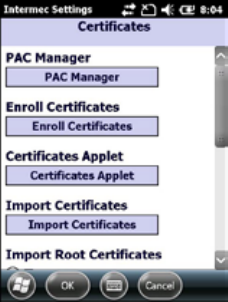
50 51
3 For Network Authentication, choose Open.
4 For Data Encryption, choose Disabled.
5 Tap OK. Your settings are saved.
Load a Certificate
To use transport layer security (TLS) with WPA or 802.1x security, you need a unique client certi-
cate on the computer and a trusted root certicate authority (CA) certicate. Certicates are pieces
of cryptographic data that guarantee a public key is associated with a private key. They contain a
public key and the entity name that owns the key. Each certicate is issued by a certicate authority.
1 Start ecom instruments Settings.
2 Go to Start > Settings > System > Intermec Settings.
3 Tap Communications > 802.11 Radio > Certicates. The
Certicates screen appears.
4 To import a certicate chain:
a Tap Import Certicates to install the selected certicate.
b In the CertImportUI screen, tap the <<< button next to the
Select pfx to import text eld.
c Select the root certicate from the list.
d Tap Import Certicate.
5 To import user and root certicates from a Microsoft IAS server:
a Tap Import Certicates.
b Tap Web Enrollment.
c Enter the User, Password, and Server (IP address) to log into
the server.
d Tap OK. A dialog box appears asking if you want to load the
root certicate.
e Tap OK. The Enrollment Tool message box appears telling you
that the certicate has been added.
f Tap OK to close the message box.
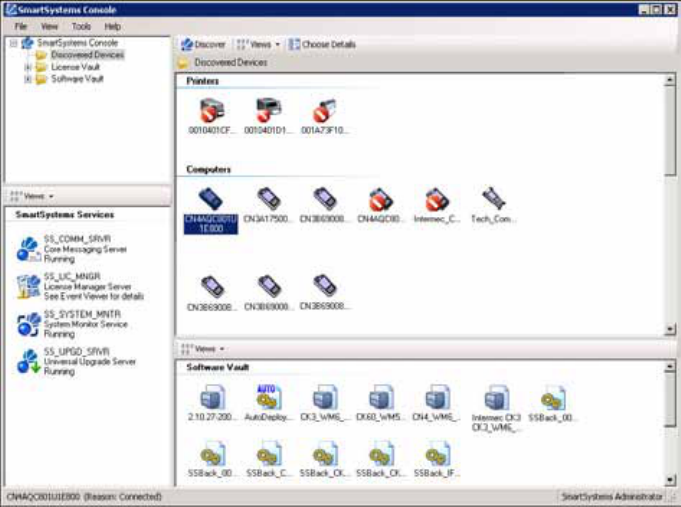
52 53
Manage the Computer in Your Network
When you have multiple mobile computers and peripherals in your
network, it is essential to have an easy way to manage updates, congure all of the devices, and
remotely troubleshoot problems. ecom instruments provides a free device management software
platform called SmartSystems™ Foundation to help you manage your devices. You can also pur-
chase third-party device management software through a vendor.
Manage the Computer Using SmartSystems Foundation
ecom instruments‘s SmartSystems Foundation is a software platform that lets you manage all of
your SmartSystems-enabled devices simultaneously from a central server. The SmartSystems
Foundation console displays all SmartSystems-enabled computers and peripherals in your net-
work.
Intermec SmartSystems Foundation Console
Through the console, you can:
• drag-and-drop conguration bundles, operating system updates, and rmware upgrades
to multiple computers.
• save conguration settings from a single device and deploy those settings to many
devices simultaneously.
• remotely change settings on SmartSystems-enabled computers and peripherals. The
SmartSystems Foundation console can report on asset locations and battery status,
making it easier to manage your mobile devices.
6
Manage the computer
Use this chapter to learn how to remotely update, congure and monitor your ecom instruments
mobile computers. You will also nd information on installing and developing software applications
as well as how to upgrade the system software.
54 55
2 Double-click the application le to install it. The application le should appear in the
Software Vault.
3 From the SmartSystems console in the Software Vault, drag-and-drop the application onto
each mobile computer in your network, or drop the application on a group of computers
contained in a folder.
Install Applications Using Microsoft ActiveSync
When you only have a few computers to update with applications, you can copy les using Micro-
soft ActiveSync. This procedure assumes that Microsoft ActiveSync is installed on your PC and is
up and running.
1 Connect to the mobile computer via ActiveSync.
2 Copy the .cab les from your development PC to the computer.
3 Reboot or cold boot the computer.
4 After the boot process is nished, browse to the .cab les and tap the les to install them.
Install Applications Using a Storage Card
Use a storage card to install applications on one computer at a time or if you have no network con-
nection.
1 Copy your application le to the storage card.
2 Install the storage card in the mobile computer.
3 On the mobile computer, browse to the Storage Card folder and run your application.
Launch Applications Automatically
There are two ways to launch an application automatically on a cold boot:
• Set up your .cab le to place a shortcut to the application in the \Windows\StartUp directory
at install time.
• Use AutoRun.exe to start your application at boot time. AutoRun ships on the computer and
automates other operations.
At boot time, AutoRun executes any commands found in its data le,
Autouser.dat. For more information on how to use the AutoRun.exe feature, view the Readme.txt le
located in the My Device\Flash File Store\2577 directory on your computer.
Update the System Software
The mobile computer uses SmartSystems bundles to update the operating system (OS) and the
system software.
You can use these methods to update your mobile computer:
• You can update individual computers, or multiple computers at the same time using the
SmartSystems console. For help, see the next section, Update Individual or Multiple
Computers Using the SmartSystems Console”.
• You can update individual computers using a microSD card.
Update Individual or Multiple Computers Using the SmartSystems Console
You can use the SmartSystems console to update the operating system or system software on your
mobile computer. The console is part of SmartSystems Foundation and is available from the ecom
instruments website. Before you can update your mobile computer, you need:
• SmartSystems Foundation. To download SmartSystems Foundation,
go to www.intermec.com/SmartSystems and click the Downloads tab.
With a Provisioning license, SmartSystems Foundation can automatically push software, congura-
tion settings, and other les to connected mobile computers. The license also enables ScanNGo,
which makes connecting additional mobile computers to your wireless network as easy as reading
bar codes. You can download SmartSystems Foundation from the ecom instruments website at no
charge. For more information, visit www.intermec.com/SmartSystems. To purchase a Provisioning
license, contact your local Intermec sales representative.
Manage the Computer Using Third-Party Software
You can use third-party software such as Wavelink Avalanche to centrally manage your ecom
instruments devices. Device management software enables you to update software, increase
security, track your assets, and troubleshoot devices remotely. You can download the Wavelink
Enabler for the mobile computer from the Wavelink website. For more information, visit the ecom
instruments website and search for Wavelink Avalanche or visit www.wavelink.com to download
the enabler.
Develop and Install Applications
Use the Intermec Resource Kits to develop applications to run on the mobile computer. The
Resource Kits are a library of C++, .NET, Java, and web components grouped by functionality
that you can use to create applications for the computer. The Resource Kits are part of the ecom
instruments Developer Library (IDL), and can be downloaded from the ecom instruments website
at www.intermec.com/idl.
For more information, see the Intermec Developer Library Resource Kit Developer Guide.
Package Your Application
For very simple applications, the executable le may be the only le you need to deploy. More typi-
cally, you will have a set of les to install.
ecom instruments recommends using .cab les to install your applications. The computer uses
standard Windows Mobile .cab les and will install third-party .cab les.
Choose a Target Location
You can have your .cab le place your application in any of these memory locations on the mobile
computer:
• The ObjectStore.
• The optional microSD card. Depending on available disk space, you may want to consider
installing your application les on the microSD card. Using a card creates the Storage
Card folder on the computer.
• The non-volatile Flash File Store. Applications and data in the Flash File Store will persist
through a clean boot.
Note: The Flash File Store is erased if you reflash the operating system image�
Files copied to any of these locations are safe when you cold boot the computer as long as the
AutoRun system is installed in the appropriate location. When AutoRun is installed on the computer,
all .cab les in the CabFiles folder are automatically extracted after a cold boot. For more informa-
tion about AutoRun, see the ecom instruments Developer Library Resource Kit Developer Guide.
Install Applications Using SmartSystems Foundation Console
You can use the SmartSystems console to drag-and-drop ecom instruments applications onto your
mobile computer. The console is part of SmartSystems Foundation.
1 Download your application le from the ecom instruments website and unzip it on your
desktop PC.
56 57
• the SmartSystems bundles you want to install. These SmartSystems bundles are available
from the ecom instruments website at www.intermec.com. Go to Support > Downloads >
OS/Firmware/Drivers list.
After you have located these items, you can update your mobile computer using SmartSystems
Foundation.
1 Open the SmartSystems console.
2 Make sure the mobile computer is discovered.
3 Make sure the mobile computer is in a powered dock or that power management is
disabled.
4 Download the SmartSystems bundle to your PC.
5 Double-click the SmartSystems bundle on your PC to extract the update les to the
software vault.
6 From the SmartSystems console, locate the bundle to install and drag them to each mobile
computer (or group in a folder) you want to update. The SmartSystems console installs the
update on your mobile computers.
After the download is complete, your mobile computer begins the update process and automati-
cally performs a cold boot. The computer then boots into a special Update Loader mode where
the computer has no network connections and is completely unusable. This process can take
anywhere from 30 seconds to 15 minutes depending on the update.
After the update is complete, the computer boots again.
Note: The SmartSystems console indicates that your mobile computer is offline, by
displaying a red stop symbol, until the computer reboots and reconnects to the system�
Update Individual Mobile Computers Using a microSD Card
You can transfer upgrade bundles from your desktop PC to your mobile computer using a storage
card. Before you can update your mobile computer, you need:
• the SmartSystems bundles you want to install. These SmartSystems bundles are available
from the Intermec website at www.intermec.com. Go to Support > Downloads >
OS/Firmware/Drivers list.
• a microSD card formatted to FAT or FAT32.
After you have located these items, you can update your mobile computer using a storage card.
1 Download the SmartSystems bundle to your PC and note the download location.
2 On your desktop PC, navigate to the download location and select the folder with the
correct rmware version. For example, umts_wwe or umts_tp.
3 Transfer the autoash.img le into the root directory of the microSD card.
4 Turn off your mobile computer and install the microSD card in your mobile computer.
For help, see Insert a MicroSD Card” on page 29.
5 Turn on your mobile computer. The update process begins. Your mobile computer may
restart several times during this process. When the update is complete, the Autoash
Complete message appears.
6 Remove the microSD card.
7 Reboot your mobile computer and follow the setup process.
Note: If you do not remove the storage card, the update process repeats each time the
computer reboots�
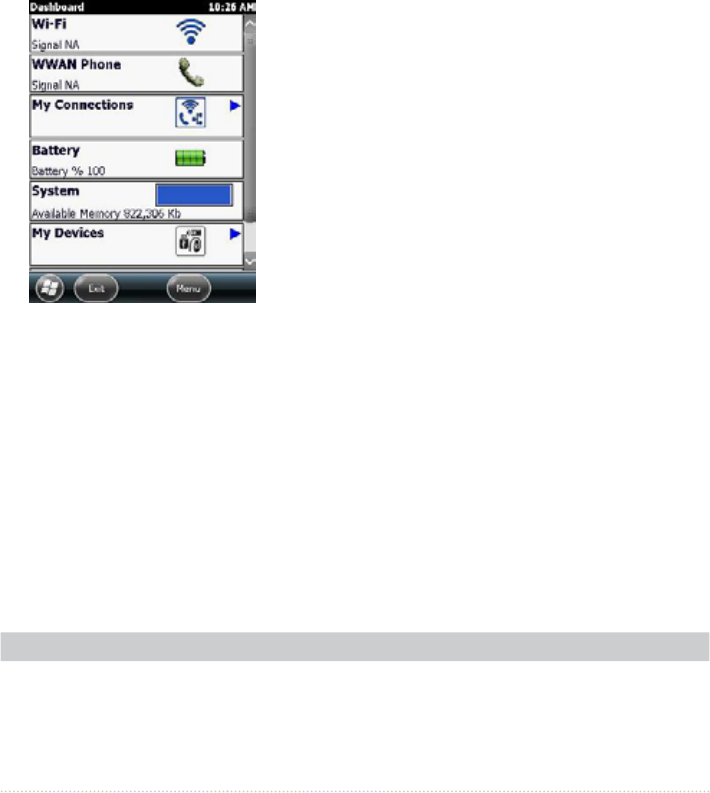
58 59
About the Intermec Dashboard
The Intermec Dashboard is designed to provide proactive monitoring of your mobile computers to
prevent downtime. You can easily see the health of the device and can help pinpoint the source of
a problem to determine if it is hardware or software related.
Intermec Dashboard displays information such as the status of network connections, battery us-
age, storage space, and internal devices. It also provides system information such as the operat-
ing system, rmware, and hardware conguration.
• Press the Intermec Dashboard button (m) on the computer keypad.
Intermec Dashboard Main Screen
Intermec Dashboard is highly integrated with SmartSystems Foundation. You can use SmartSys-
tems Foundation to remotely monitor the health of your computers. For more information, refer to
the SmartSystems online help.
Troubleshoot Your Mobile Computer
Use the troubleshooting tables in this section to x problems with the Wi-Fi connection, 802.1x
security, the imager, or general problems with operating the mobile computer.
If you send the computer in for service, it is your responsibility to save the computer data and con-
guration. ecom instruments is responsible only for ensuring that the hardware matches the original
conguration when repairing or replacing the computer.
Troubleshoot the Wi-Fi Connection
Use this troubleshooting table to help solve problems with your 802.11 radio connection.
Problems With the Wi-Fi Connection
Problem Solution
When you turn on the com-
puter after it was suspended
for a while (10 to 15 minutes
or longer), it can no longer
send or receive messages
over the network.
Host may have deactivated or lost current terminal emulation ses-
sion. In a TCP/IP direct connect network, turn off the Keep Alive”
message from host to maintain the TCP session while the com-
puter is suspended.
7
Troubleshoot and Maintain the computer
If you encounter any problems while using the i.roc® Ci70 -Ex computer, look in this chapter to nd
a possible solution. You will also nd information on routine maintenance.

60 61
Check 802�11 Network Status
If you have trouble connecting to your 802.11 wireless network:
• Make sure you have correctly set network parameters on the computer.
• Check your wireless security settings.
Follow the next procedure to verify available access points and networks, check signal strength,
and view other diagnostics. If you need to contact ecom instruments Product Support, this informa-
tion can be helpful in troubleshooting wireless network connection issues.
1 Tap Start > iSpyWiFi. The ISpyWiFi application launches.
The ISpyWiFi tab shows:
• MAC address and IP address of the 802.11 radio.
• network association status, including the SSID and MAC address of the access point.
• security conguration.
• radio transmit power and signal strength information.
2 Tap the Scan tab to view a list of available 802.11 networks. The list includes the signal
strength, channel, and MAC address for each network.
• Tap Scan to refresh the screen.
3 Tap the Supp tab to view radio supplicant information, including a list of supplicant events
and authentication status.
• To verify the settings for the currently active security prole, tap Congure Prole.
ecom instruments Settings launches for you to congure 802.11 Radio settings.
• To try reconnecting to the network, tap Reconnect.
• To delete the events in the list, tap Clear Events.
4 Tap the Ping tab to run a ping test to the host.
a In the Host eld, enter the IP address of the host.
b From the Repetitions list, choose the number of times the computer will ping the host.
c Tap Ping. The graph shows the amount of time it takes for the host to return the ping.
Tap List to see this information in a list format.
5 Tap the RSSI tab to view the received signal strength of the host signal. The information
box includes the current signal strength, host SSID name, MAC address, data rate, and
transmit power.
• Tap Mark to place an arrow marker above the graph.
6 Tap the Conf tab to set up a log le that lists RSSI history. This screen includes the 802.11
radio driver version and available radio modes.
a Check the Log to File check box.
b (Optional) Change the sample period and number of samples displayed.
c Tap Log File. The Save As screen appears.
d (Optional) Change the name of the saved log le, the folder to which the le will be saved,
the content type (log or text), and the location.
e Tap OK.
Troubleshoot Reading Bar Codes
Use this section to troubleshoot problems that may prevent you from being able to read a bar
code, such as the symbology not being enabled.
The computer is connected
to the network and you move
to a new site to collect data.
Your computer now shows
you are not connected to the
network.
Move closer to an access point or to a different location to rees-
tablish communications until you reconnect with the network.
The computer appears to be
connected to the network, but
you cannot establish a termi-
nal emulation session with the
host computer.
There may be a problem with the host computer, or with the con-
nection between the access point and the host computer. Check
with the network administrator to make sure the host is running
and allowing users to log in to the system.
The computer appears to be
connected to the network, but
the host computer is not re-
ceiving any information from
the i.roc® Ci70 -Ex computer.
There may be a problem with the connection between the access
point and the host computer. Check with the network administrator
or use your access point user’s manual.
A network connection icon
appears in the toolbar, but
then disappears.
The computer may not be communicating with the intended ac-
cess point. Make sure the network name matches the access
point network name. Default network name is INTERMEC.”
The access point may not be communicating with the server. En-
sure the access point is turned on, properly congured, and has
802.1x security enabled.
Troubleshoot 802�1x Security
Use the following table to troubleshoot problems with your 802.1x security that will prevent you
from connecting to your network, such as an incorrect password.
Problems With 802�1x Security
Problem Solution
The computer indicates it is
not authenticated.
Make sure that:
• the User Name and Password parameters on the computer
must match the user name and password on authentication serv-
er. You may need to reenter the password on both the computer
and authentication server.
• on your authentication server, the user and group are allowed
and the group policy is allowed to log into the server. For help, see
the documentation that shipped with your authentication server
software.
• the IP address and secret key for access point must match the
IP address and secret key on the authentication server. You may
need to reenter the IP address and secret key on both your ac-
cess point and authentication server.
• the authentication server software is running on the server PC.
You receive a message say-
ing The server certicate has
expired or your system date
is incorrect” after you perform
a clean boot on the computer.
Date and time are not saved when you perform a clean boot.
Reenter the date and time, and then save your changes.

62 63
Use ScanDiagnostic to Troubleshoot the Scanner
Use the ScanDiagnostic application to troubleshoot problems such as the inability to read a bar
code or a scanner that does not turn on.
1 From the Home menu, tap Start > ScanDiagnostic.
2 From the Scan Health screen, select the scanner you want to troubleshoot and then tap
Diagnose.
The application checks to make sure the scanner is enabled and checks settings to make
sure they are optimized.
3 From the Scan Test screen, press and hold the Press to Scan button while aiming at the
bar code you want to read.
After the computer scans the bar code, it beeps and the label data, data length, and
symbology appear on the screen.
4 Press the right arrow button to view any recommended settings.
5 To accept the recommended settings, tap Apply.
6 Tap OK to exit.
Troubleshoot Operating the Computer
Use this section to troubleshoot problems that may prevent you from being able to operate the
computer.
Problems Operating the Computer
Problem Solution
You press the Power button
and nothing happens.
Try the following solutions:
• Replace or charge the battery. The battery may be completely
drained.
• Remove the battery and press the Reset button to perform a
cold boot. For help, see Cold Boot the Computer” on page 115.
The computer appears to
belocked up and you cannot
enter data.
• Press the Power button and select Suspend from the Power
Options menu. Press the Power button to turn the screen
back on.
• Press the Power button and select Reboot from the Power
Options menu.
• Remove the battery and press the Reset button to perform a
cold boot. For help, see Cold Boot the Computer” on page 115.
• Try reloading the rmware. For help, see Update the
System Software” on page 102.
• If the computer does not boot or reset, contact your ecom
instruments representative for help.
The accelerometer does not
appear to be accurate.
You may need to calibrate the accelerometer using the Sensor
Calibration application. Tap Start > Settings > System > Sensor
Calibration. Rotate the computer to calibrate all six orientations.
You tap the screen and noth-
ing happens.
Align your screen. For help, see Align the Screen” on page 43.
You cannot type a character
on the keypad or you can
only type uppercase or lower-
case letters.
You may have locked a modier key on the keypad. Press the
necessary key sequence to unlock the key. For help, see About
the Keypad” on page 15.
Problems Reading Bar Codes
Problem Solution
You cannot see the illumina-
tion beam or frame from the
imager when you press the
Scan button and aim the im-
ager at a bar code label.
• You may be too far away from the bar code label. Try moving
closer to the bar code label and scan it again.
• You may be reading the bar code label straight on.” Change
the reading angle and try again.
• The imager hardware trigger might be disabled in ecom in-
struments Settings. To check the setting go to Start > Set-
tings > Systems > Data Collection > Scanner Settings. Hard-
ware trigger should be checked.
When you release a Scan
button or handle trigger, the
Good Read light does not
turn off.
The Good Read light will remain on if you congure the computer
to use continuous/edge triggering. If you congure the computer
for level triggering and the Good Read light remains on, there may
be a problem. Press one of the Scan buttons or pull the trigger
again without scanning a bar code label. If the light is still on,
contact your local ecom instruments representative.
The scanner will not read the
bar code label.
• Aim the scanner beam to cross the entire bar code label in
one pass. Vary the scanning angle.
• Check the quality of the bar code label. Scan a bar code
label that you know will scan. Compare the two bar code
labels to see if the bar code quality is too low. You may need
to replace the label that you cannot scan.
• Make sure the bar code symbology is enabled and cong-
ured correctly. Use ecom instruments Settings to check the
symbologies. Expand Data Collection > Symbologies be-
neath devices listed (scanner, virtual wedge) to check and
enable symbologies, then scan the bar code label again.
• Make sure the computer application is expecting input from
a bar code. You may need to type this information instead.
• The scanner may not be turned on or the scanner may be
unable to scan a specic bar code. Run the ScanDiagnostic
application to help you troubleshoot the problem. For more
information, see
The scanner does not read
the bar code labels quickly,
or the scanning beam seems
to be faint or obscured.
The scanner window may be dirty. Clean the window with a solu-
tion of ammonia and water. Wipe dry. Do not allow abrasive mate-
rial to touch the window.
You scan a valid bar code la-
bel to enter data for your ap-
plication. The data decoded
by the scan module does not
match the data encoded in
the bar code label.
The computer may have decoded the bar code label in a symbol-
ogy other than the label’s actual symbology. Try scanning the bar
code label again. Make sure you scan the entire label.
The input device attached to
the computer does not work
well or read bar code labels
very quickly.
Set the Scanner Model command to the specic attached input
device. Check enabled bar code symbologies and enable only
the symbologies being used.
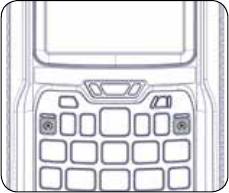
64 65
Clean Boot the Computer
L
A clean boot erases the memory in the mobile computer, including all applications and
Caution
data files, with the exception of those found in the Flash File Store, or any removable
storage�
If the computer seems to be locked up, try cold booting it. If this process does not work, use a
clean boot to get the computer up and running for further troubleshooting.
You can perform a clean boot using the mobile computer.
1 During Reeboot immediately press and hold the Power button and Volume Down button
(the lower button on the right side).
2 Continue to hold the Power button and the Volume Down button down until you are
prompted to release them.
3 Press the Volume Up button on the right side to start the clean boot.
4 Wait for the computer to load les from its ROM.
You can also perform a clean boot using the SmartSystems Console.
• Right-click the i.roc® Ci70 -Ex computer and select Intermec Power Tools > Clean Boot Device.
Clean the Computer
To keep the computer in good working order, you may need to clean the imager window, color
camera window, and the touch screen. Clean the windows and the touch screen as often as
needed for the environment in which you are using the computer. To clean the computer, use a
solution of ammonia and water.
L
There are no user-serviceable parts inside the i�roc
®
Ci70 -Ex computer�
Caution
Opening the computer will void the warranty and may cause damage to the internal
components�
1 Press the Power button and choose to suspend the computer.
2 Dip a clean cloth towel in the ammonia solution and wring out the excess.
3 Wipe off the imager window, camera lens, and ash area. Do not allow any abrasive
material to touch these surfaces.
4 Wipe dry.
Find Your Configuration Number
Use the following procedure to help you nd the conguration number of your computer.
• Look at the label on the back of the computer.
Find Your Operating System Version
Use the following procedure to nd the OS version of your mobile computer.
1 Press the Intermec Dashboard (m) button to launch the Dashboard.
2 Tap the Information bar. The Information Details page appears and displays information
such as the rmware version and the OS version.
Reset the Computer
If the computer does not resume after pressing the Power button, or if the computer or an applica-
tion locks up, you may need to reset the computer. The computer uses the conguration currently
saved in ash memory during the boot process. There are three ways to reset the computer:
• Reboot
• Cold boot
• Clean boot
Reboot the Computer
You may need to reboot the computer to correct conditions where an application stops responding
to the system.
• Press the Power button and select Reboot from the menu.
The computer systematically shuts down, restarts, and goes through the initialization process.
Cold Boot the Computer
In some cases where the computer completely stops responding, it may be necessary to perform
a cold boot or hard reset. Because cold booting may result in data loss, use this method only if all
other recovery methods have failed.
Note: Cold booting the computer does not guarantee that cached disk data will be saved,
so transactional data may be lost during the reset� All other data, such as
configuration and network settings, is preserved�
1 Press and hold both R buttons simultaneously for about 5 seconds. The computer will
reboot.
2 Wait while the mobile computer boots. When the cold boot is complete, the Home screen
appears.
Location of i�roc
®
Ci70 -Ex/ Reset Buttons
Reset button

66 67
Physical and Environmental Specifications
i�roc® Ci70 -Ex Physical Dimensions
Dimensions standard conguration
225 x 85 x 58 mm (8.8 x 3.3 x 2.3 inches)
with optional head modules
249 x 85 x 58 mm (9.8 x 3.3 x 2.3 inches)
Weight standard conguration
980 g (2.16 lb) with battery
Environmental Specifications
Operating temperature -20 °C to 50 °C (-4 °F to 120 °F)
Storage temperature -20 °C to 60 °C (-4 °F to 140 °F)
Charging temperature 5 °C to 35 °C (41 °F to 95 °F)
Relative humidity (operating) 5% to 95% non-condensing
Environmental rating IP65 compliant
Drop Specications All corners and sides from 1.2 m (4 ft) per MIL-STD 810G
Power and Electrical Specifications
Battery type Rechargeable Lithium-ion (Li-ion) battery AM Ci70 -Ex
Battery capacity 3.7 V, 4000 mAh (14.8 Wh)
Electrical rating x 4.37/4.8 V; 2/1,5 A
Operating System
Microsoft Windows Embedded Handheld 6.5.3
Hardware
Main processor options TI OMAP3, 1 GHz
Memory 512 MB RAM
Persistent storage 1 GB Flash
Removable storage up to 32 GB user-accessible microSD card slot
Keypad QWERTY, Numeric
Imaging options via optional head modules
A
Specifications and Default Settings

68 69
Radio Bands b/g (2.4 GHz)
Radio Enabled Off
Ethernet Adapter Settings
Ethernet Adapter Setting Default Value
DHCP Enabled
Bluetooth Settings
Bluetooth Setting Default Value
Bluetooth Power Off
WWAN Radio Settings
WWAN Radio Setting Default Value
WWAN Radio Enabled Enabled
Serial Port Switch
Serial Port Switch Setting Default Value
Serial Port Switch Standard Docking and IrDA
Device Settings
Use device settings to congure settings on the mobile computer.
Device Settings
Device Setting Default Value
Date N/A
Time N/A
Good Read Settings
Good Read Setting Default Value
Internal Scanner Good Read Beep One Beep
Tethered Scanner One Beep
Bluetooth Scanner Good Read Beep One Beep
Backlight Settings
Backlight Setting Default Value
Touch Screen Specifications
Transmissive VGA display with high-durability touch screen; 480 x 640 pixels; 8.9 cm (3.5 in)
diagonal active area; LED backlight and ambient light sensor.
Standard Communications
• GPS
• 802.11a/b/g/n
• Bluetooth
• USB Full Speed V2.0 Client
Optional Communications
• UMTS
• CDMA
Wireless LAN
Standards compliant IEEE 802.11a/b/g/n (2.4 GHz and 5 GHz), Single Stream
Data rates up to 72Mbps
Security 802.11i, WPA, WPA2, 802.1x (EAP-TLS, TTLS, PEAP,
EAP-FAST), WEP
Certications WPA2™ (Enterprise, Personal), WPA™ (Enterprise,
Personal), Wi-Fi, WMM®, WMM Power Save, Cisco Com-
patible Extensions (CCX 4.0)
Regulatory Approvals
FCC, CE, cULus Listed, DEMKO
Communications
Use communications settings to congure how the mobile computer communicates with the net-
work.
Communications Settings
Communications Setting Default Value
Device Name ecom instruments CXXX (where XXX indicates
the model of mobile computer)
802.11 Radio Settings
802.11 Radio Setting Default Value
Security Choice Funk Allow Security Changes
Enabled Active Prole Prole 1
DHCP Enabled
Import Root Certicates False
Import User Certicates False
Import Pac Files False

70 71
Enable Camera Scan Show Option in Prole Settings
Power
Always On Show Option in Prole Settings
Maximize Battery Life Show Option in Prole Settings
Normal Show Option in Prole Settings
Scanning
1D Bar Codes Optimized Show Option in Prole Settings
Bright Sunlight Show Option in Prole Settings
Reective Labels Show Option in Prole Settings
Standard Show Option in Prole Settings
GPS Settings
Use GPS settings to congure how the mobile computer communicates with the GPS network.
GPS
GPS Setting Default Value
Enable Bread Crumbing Disable
Core Messaging Service Settings
Use core messaging service settings to congure the message routers between client and server
software applications.
Core Messaging Service
Core Messaging Service Setting Default Value
Associated Server IP Null Broadcast Name
INTERMEC Port 62241
Keep Alive Ping Interval 30 Seconds
Device Monitor Settings
Use device monitor settings to congure how the mobile computer monitors the network.
Device Health Controls
Device Health Setting Default Value
Enable Health Data Collection On
Enable Device Health Application On
Enable Blue Light Off for Ready-to-Work
Set Rule File Location \SmartSystems\HealthRules.txt
System Device Health Refresh (seconds) 90
Network Device Health Refresh (seconds) 45
Display Backlight Adjustment Normal
Keypad Backlight On Based on Light Level
Light Level Low
Screen Settings
Screen Setting Default Value
Screen Rotations Portrait 0 Degrees
Screen Rotation Sensor Disabled
Sound Settings
Sound Setting Default Value
Beeper and Voice Medium
Headset Beeper Very Low
Vibrate Mode Intensity 1 Strong Pulse
Screen Taps Off
Key Clicks Off
Keypad Settings
Keypad Setting Default Value
Button Remapping Scanner
Power Management Settings
Power Management Setting Default Value
Enable Power Button Screen On
Screen Options Displayed Hibernate, Suspend, Reboot
Screen Timeout (Seconds) 5
Power Button Behavior Suspend
Device Turns Off After (Battery Power) 5 minutes
Screen Turns Off After (Battery Power) Disabled
Device Turns Off After (External Power) Disabled
Screen Turns Off After (External Power) Disabled
Device Off Sensor Disabled
Profiles Settings Application
Profiles Settings Default Value
Camera
Disable Camera Scan Show Option in Prole Settings

72 73
Device Health Screen Captures
Device Health Screen Captures Setting Default Value
Directory \SmartSystems\ScreenCapture
Screen Captures Allowed 3
Device Wipe
Device Wipe Setting Default Value
Enable Wipe Disabled
Head Modules Settings
Additional settings and intantion are provided separatly on www.intermec.com.
Head Modules Settings
Settings Default Value
Enable Module No USB Device
No UART Device
Virtual Wedge Settings
Use virtual wedge settings to congure the virtual wedge.
Virtual Wedge Setting
Setting Default Value
Virtual Wedge Ena b l e Ba r C ode S c anne r G rid
Null Label Encoding (Code Page) 1252
Magstripe Reader Grid Null

74 75
Standard Characters
Use the following tables to learn how to enter standard and other available characters and func-
tions with the keypad. If there is no sequence of keystrokes for a particular character or function, it
is only available through the soft input panel (SIP), which you can access by tapping the keyboard
icon on the touch screen.
i�roc® Ci70 -Ex Keypads and Keystrokes
i�roc
®
Ci70 -Ex Alphanumeric Characters
Character Numeric Keypad QWERTY Numeric Keypad
a c 2 A
b c 2 2 B
c c 2 2 2 C
d c 3 D
e c 3 3 E
f c 3 3 3 F
g c 4 G
h c 4 4 H
i c 4 4 4 I
j c 5 J
k c 5 5 K
l c 5 5 5 L
m c 6 M
n c 6 6 N
o c 6 6 6 O
p c 7 P
qc 7 7 Q
r c 7 7 7 R
s c 7 7 7 7 S
t c 8 T
u c 8 8 U
v c 8 8 8 V
w c 9 W
x c 9 9 X
y c 9 9 9 Y
z c 9 9 9 9 Z
A c 1 2 y A
B c 1 2 2 y B
C c 1 2 2 2 y C
B
Keypads and Keystrokes

76 77
i�roc
®
Ci70 -Ex Characters and Funktions
To Enter Numeric Keypad QWERTY Numeric Keypad
@ (at symbol) N/A b Q
& (ampersand) N/A b U
* (asterisk) * *
: (colon) N/A b I
, (comma) N/A ,
$ (dollar) N/A b E
! (exclamation) N/A b O
- (hyphen) - -
% (percent) N/A b R
. (period) . .
+ (plus) b - b -
# (pound) # #
? (question mark) N/A b Y
‘ (apostrophe) N/A b W
Forward Tab j j
Backspace { {
Up Arrow u u
Down Arrow d d
Left Arrow l l
Right Arrow r r
CapsLock c 1 y y
Enter e e
ok b | b |
Shift b or c b or y
Space c 0 s
Start (Windows) b m or c m b m
Esc | |
Dashboard m m
D c 1 3 y D
E c 1 3 3 y E
F c 1 3 3 3 y F
G c 1 4 y G
H c 1 4 4 y H
I c 1 4 4 4 y I
J c 1 5 y J
K c 1 5 5 y K
L c 1 5 5 5 y L
M c 1 6 y M
N c 1 6 6 y N
O c 1 6 6 6 y O
P c 1 7 y P
Q c 1 7 7 y Q
R c 1 7 7 7 y R
S c 1 7 7 7 7 y S
T c 1 8 y T
U c 1 8 8 y U
V c 1 8 8 8 y V
W c 1 9 y W
X c 1 9 9 y X
Y c 1 9 9 9 y Y
Z c 1 9 9 9 9 y Z
0 0 0
1 1 1
2 2 2
3 3 3
4 4 4
5 5 5
6 6 6
7 7 7
8 8 8
9 9 9
78 79

PA000433 / ------- / 12 / 2012
WEEE-Reg.-Nr. DE 934 99306
300011AL01A00
Änderungen vorbehalten! Subject to change!
ecom instruments GmbH · Industriestr. 2 · 97959 Assamstadt · Germany
Tel.: + 49 (0) 62 94 / 42 24 0 · Fax: + 49 (0) 62 94 / 42 24 100
E-Mail: sales@ecom-ex.com · www.ecom-ex.com
80
Copyright© 2012 ecom instruments GmbH.
The contents of this document, either in part or in their entirety, may not be reproduced, forwarded, distributed
or saved in any way without ecom instruments GmbH prior written consent.
The contents of this document are presented as they currently exist. ecom instruments GmbH does not provide
any express or tacit guarantee for the correctness or completeness of the contents of this document, including,
but not restricted to, the tacit guarantee of market suitability or fitness for a specific purpose unless applicable laws
or court decisions make liability mandatory. ecom instruments GmbH reserves the right to make changes to this
document or to withdraw it any time without prior notice.
Copyright© 2012 ecom instruments GmbH.
Der Inhalt dieses Dokuments darf ohne vorherige schriftliche Genehmigung durch die ecom instruments GmbH in
keiner Form, weder ganz noch teilweise vervielfältigt, weitergegeben, verbreitet oder gespeichert werden.
Der Inhalt dieses Dokuments wird so präsentiert, wie er aktuell vorliegt. Die ecom instruments GmbH übernimmt
weder ausdrücklich noch stillschweigend irgendeine Gewährleistung für die Richtigkeit oder Vollständigkeit des
Inhalts dieses
Dokuments, einschließlich, aber nicht beschränkt auf die stillschweigende
Garantie der Markt-
tauglichkeit und der Eignung für einen bestimmten Zweck, es sei denn, anwendbare Gesetze oder Rechtsprechungen
schreiben zwingend eine Haftung vor. Die ecom instruments GmbH behält sich das Recht vor, jederzeit ohne
vorherige Ankündigung Änderungen an diesem Dokument vorzunehmen oder das Dokument zurückzuziehen.